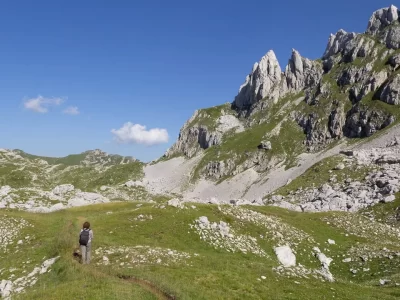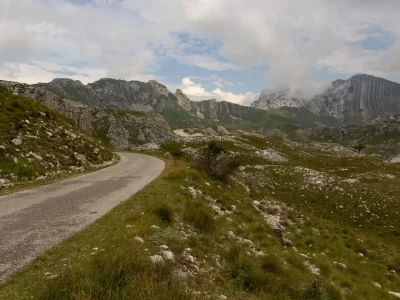A beach vacation with a side of history: that’s my definition of Budva, a coastal town in Montenegro that offers the best combination of both.
This place goes back to the times of Greeks, Illyrians, and Romans. All this history is framed between the Dinaric Alps in the background and the blue of the Adriatic Sea.
I spent a week exploring the coast of the Budva Riviera, which is dotted with beaches, cliffs and forts that form a memorable landscape.
And one of its best features is that you can explore it on foot, making your way along beaches connected through paths with scenic views.
Disclosure: This post contains some affiliate links. If you make a purchase through those links I will earn a commission at no additional cost to you (zero, nada). To check the full disclaimer, click here.
This is your guide of what to do and see in Budva, Montenegro
Table of Contents
Budva Old Town (Stari Grad)

Behind the thick stone walls surrounding Budva Old Town you’ll find a maze of narrow alleyways connecting tiny squares with centuries-old small treasures.

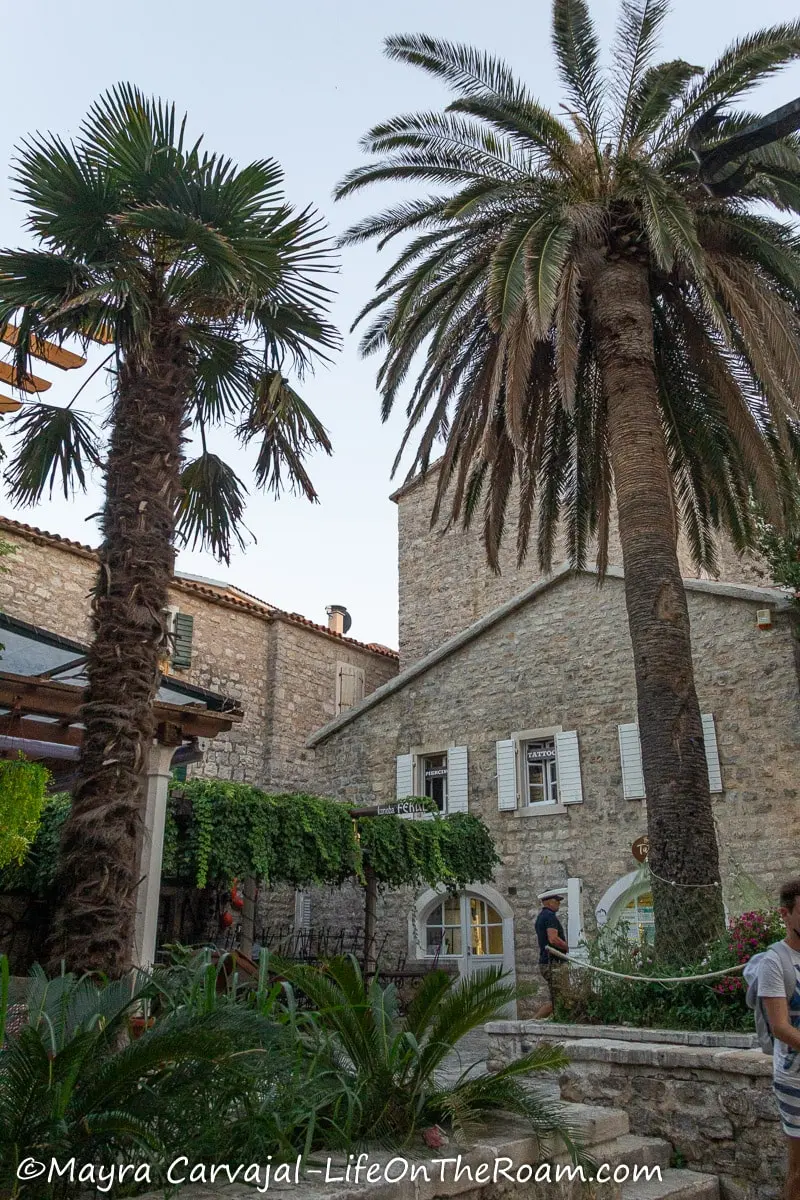
Treasures like a Roman sacrificial altar (1st-2nd century A.D.) made of stone with the inscription “VINICIA PAVLINA”, discovered on site after the 1979 earthquake. Or the ornamented capitals and architrave in Villa Urbana Piazzetta, a square with remains of a Roman Villa from the 1st-2nd century A.D.
Some items, like the ancient pylons that were part of a gate of a Greek-Illyrian settlement during the 7th-6th century B.C., lay underground inside a store.
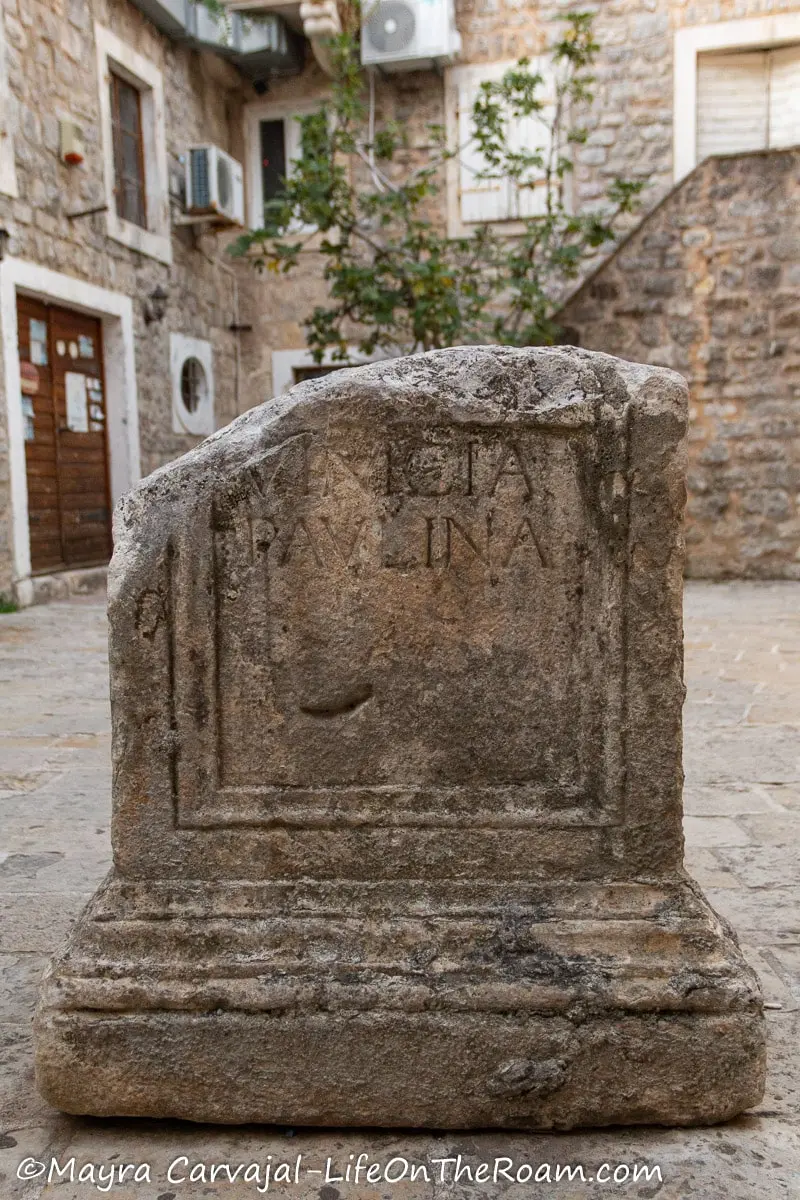

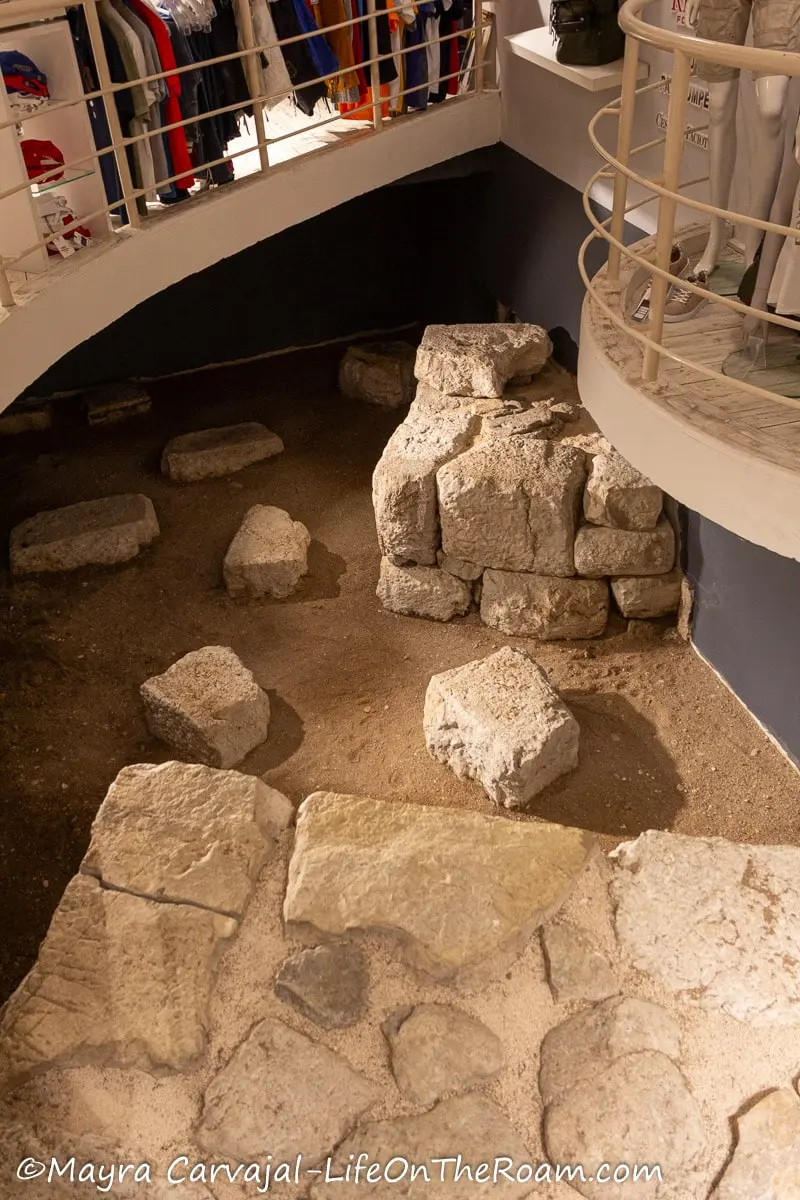
With its medieval churches, a seaside citadel, and remains of structures from Roman times, Budva Old Town could be a backdrop for a Game-of-Thrones-like series. This lively place is also home to a museum, antique shops and art galleries, cafés, and all sorts of little stores
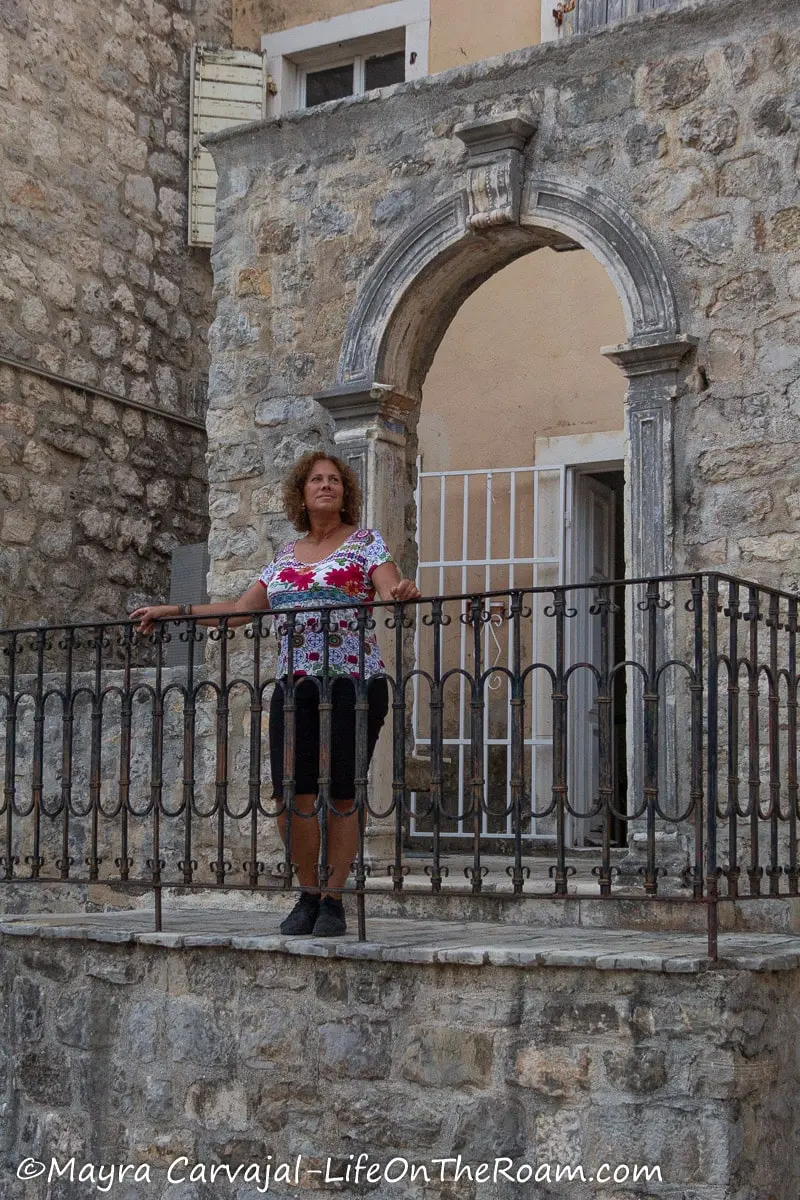
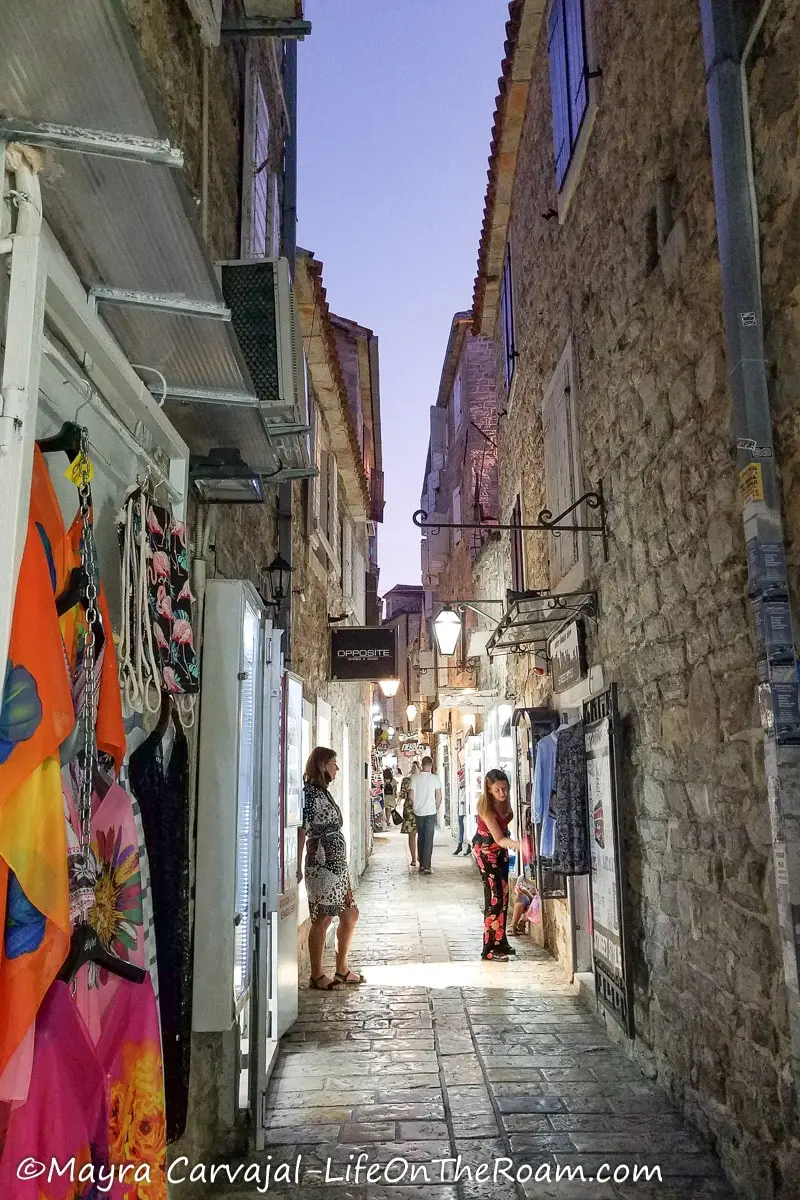
Budva City Museum
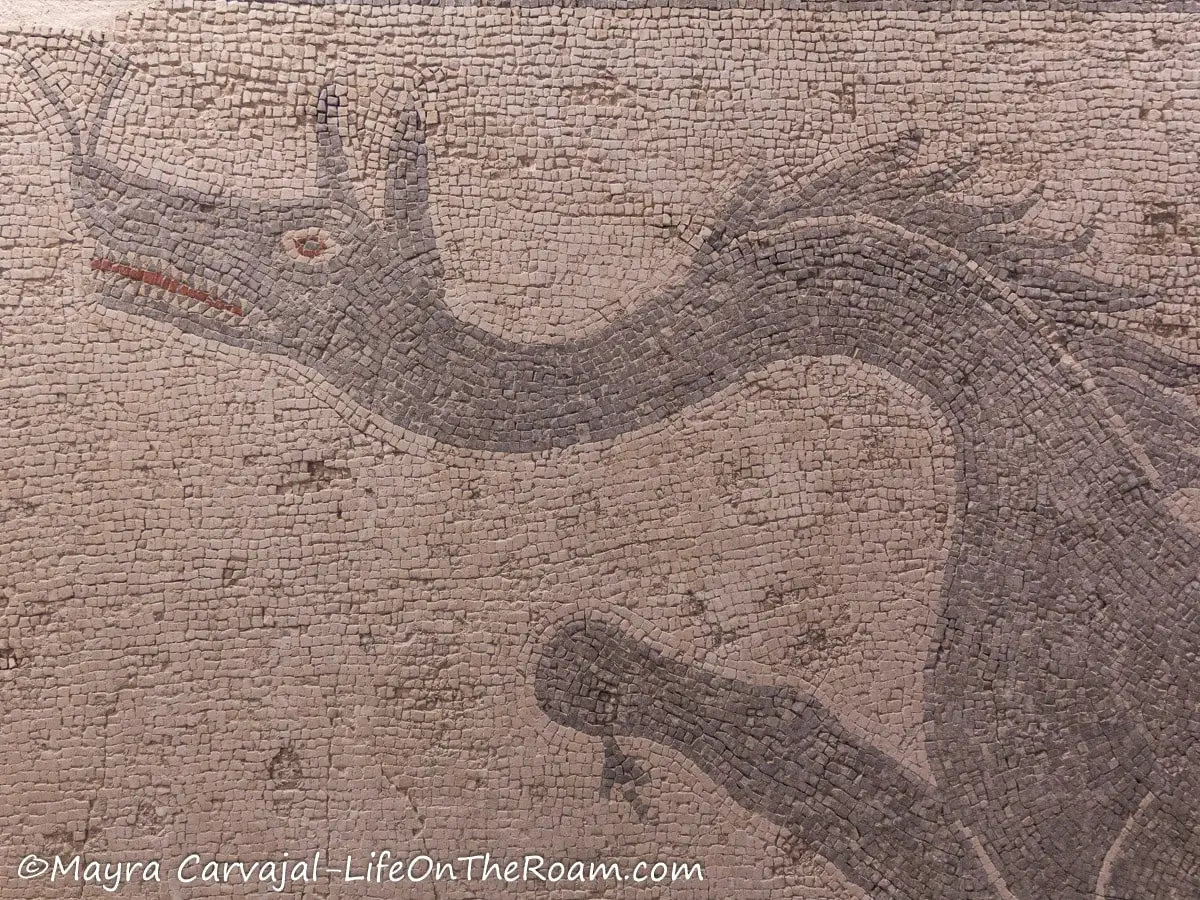
Even though the museum isn’t big and the displays are on the old side, its small collection has interesting objects that will offer an insight into the complex history of Budva. The timeline goes as far back as the 5th century B.C. when the region developed from a Greek settlement named Buthoe to a Roman and Byzantine enclave, and beyond.
You can also see an ethnographic collection with items from the 18th to the early 20th century.
Some of the oldest items are from Budva’s Hellenistic period (5th-2nd century B.C.), like the Illyrian-Greek helmet and the gold jewelry recovered from the necropolis after the 1979 earthquake.
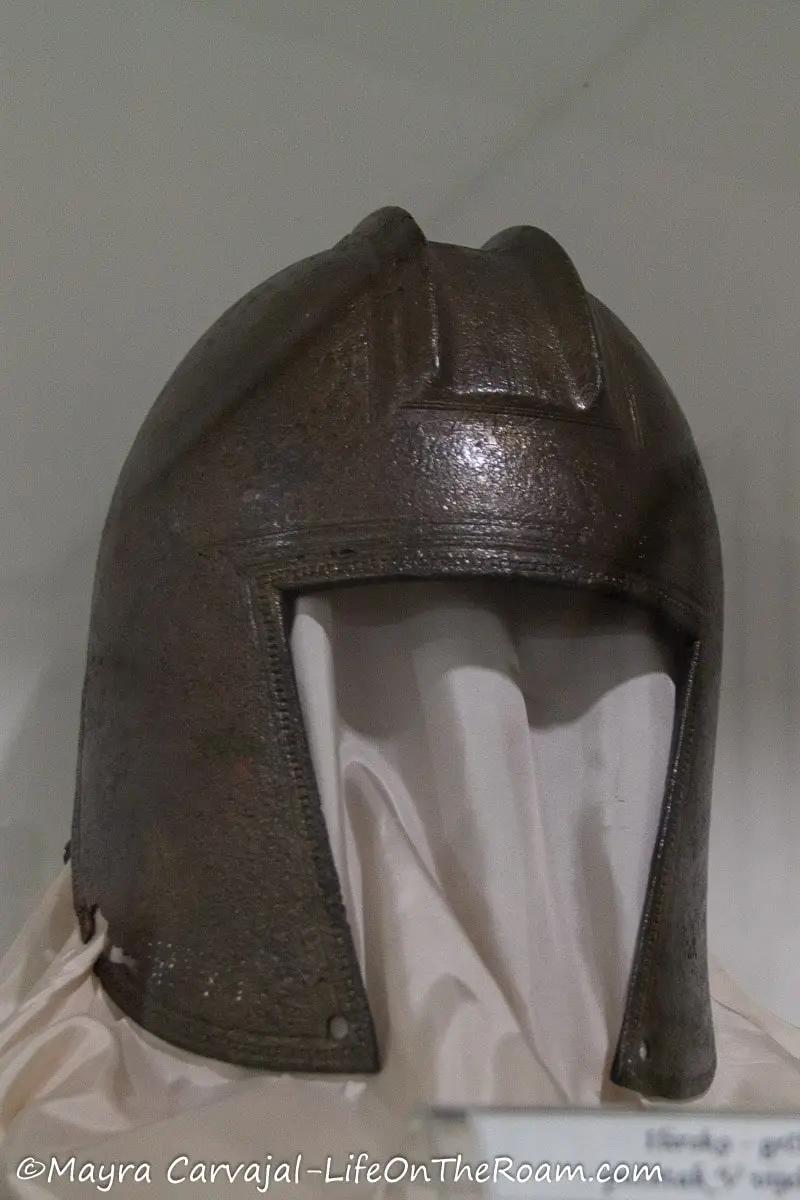

They also have a few pottery pieces from this period (4th-2nd century B.C.)
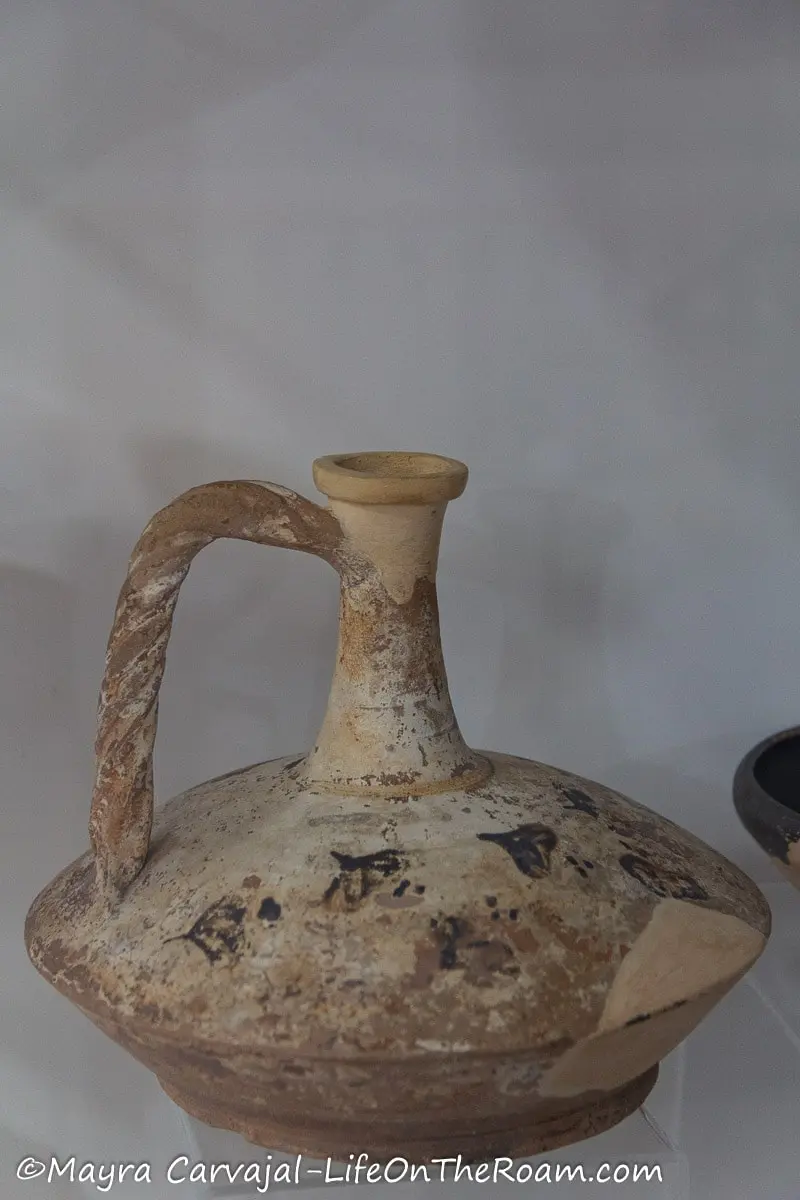
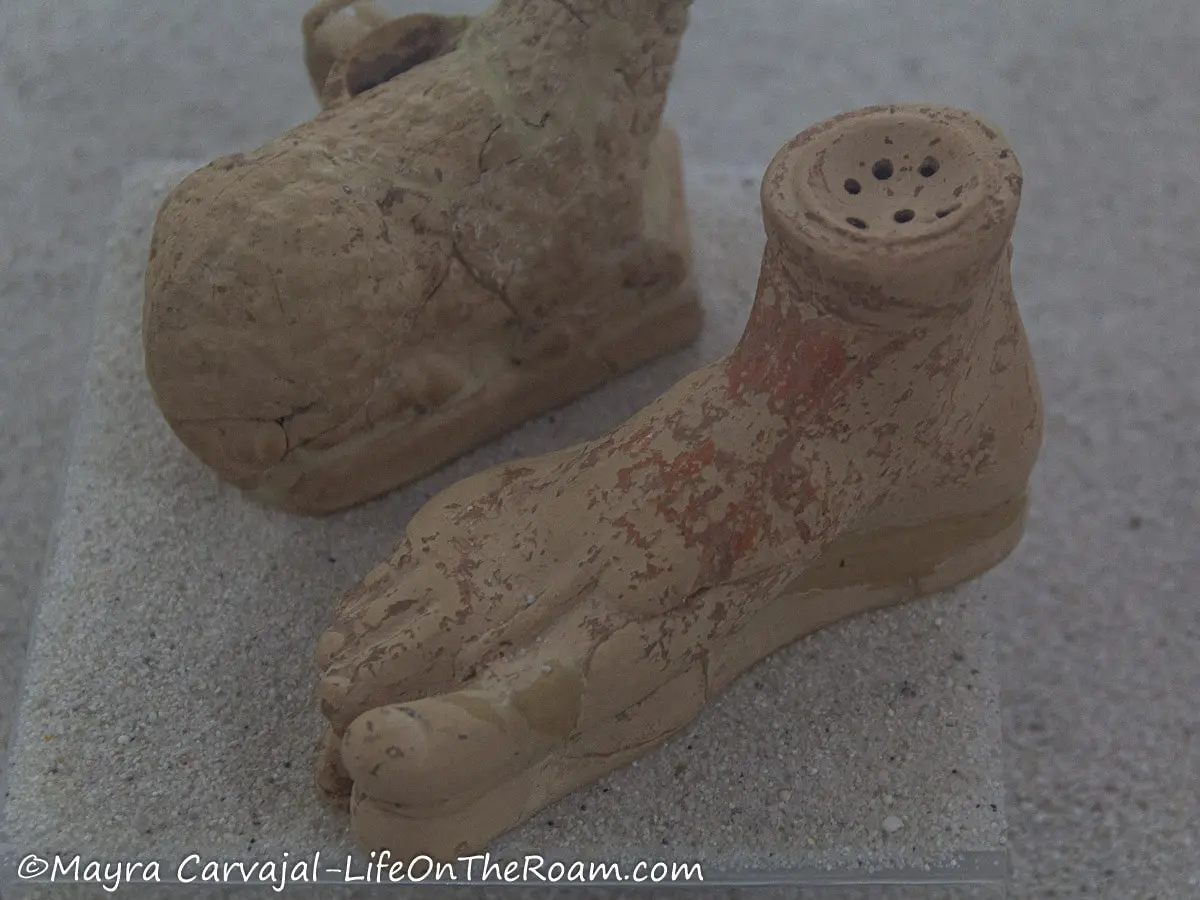
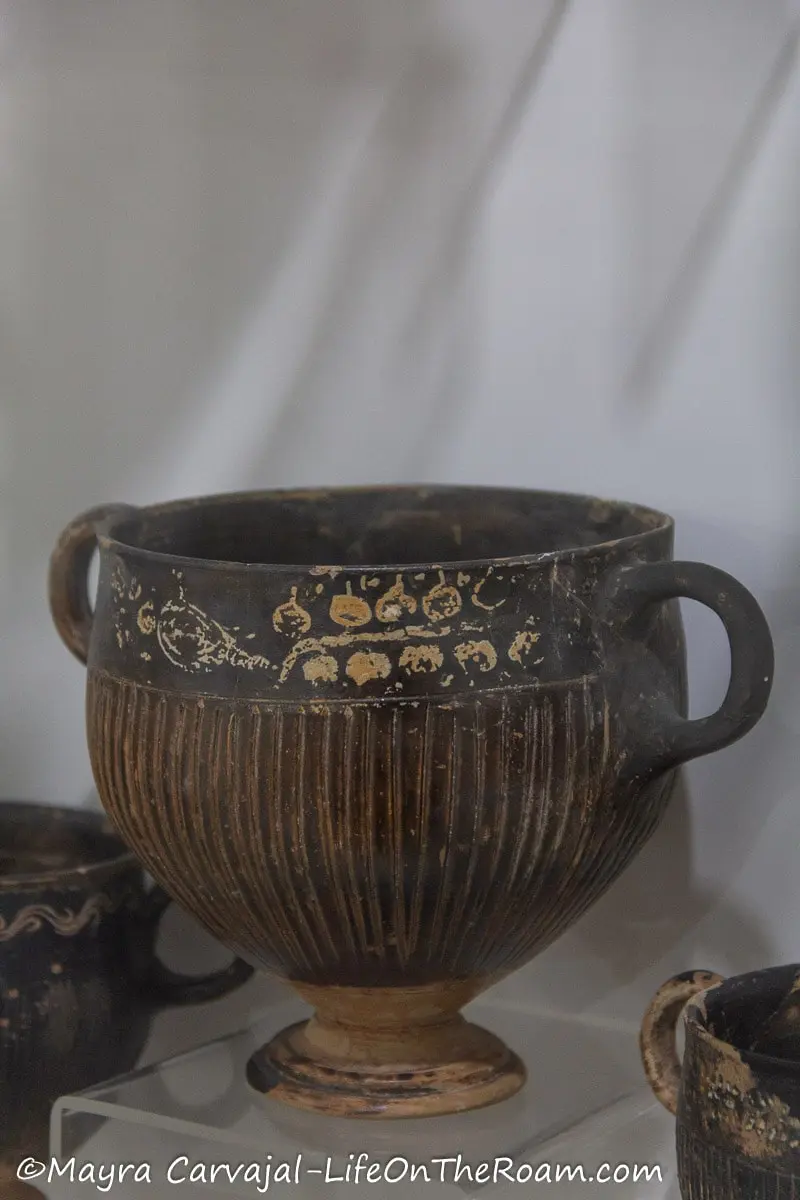
The Roman Empire took over for the next four centuries. During the peak of the Roman ruling (1st-2nd century A.D.), Budva was a prosperous town that expanded like pizza dough.
There are some interesting pieces of the Roman era, such as coins from when Caesar Augustus was the emperor, and this mosaic from the 1st century, found right outside the Old Town walls.
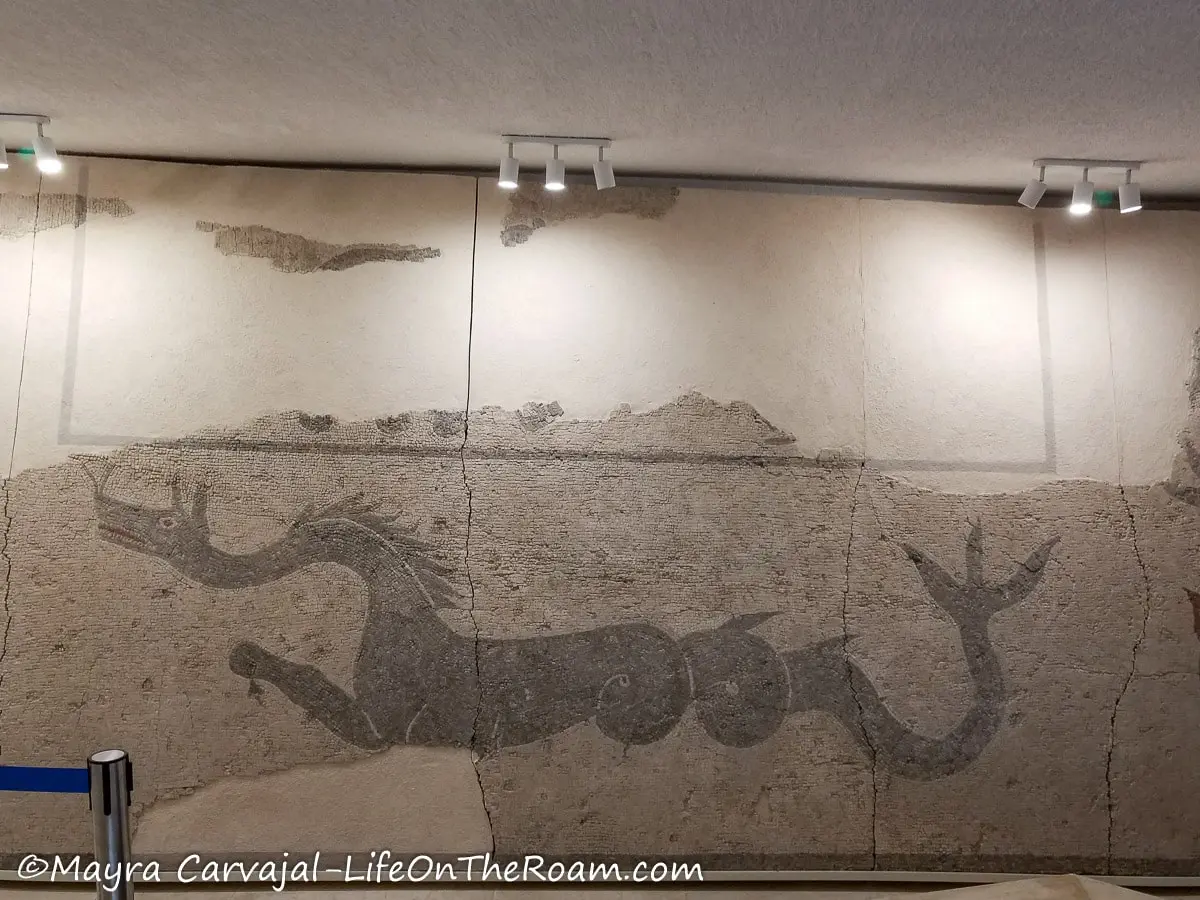
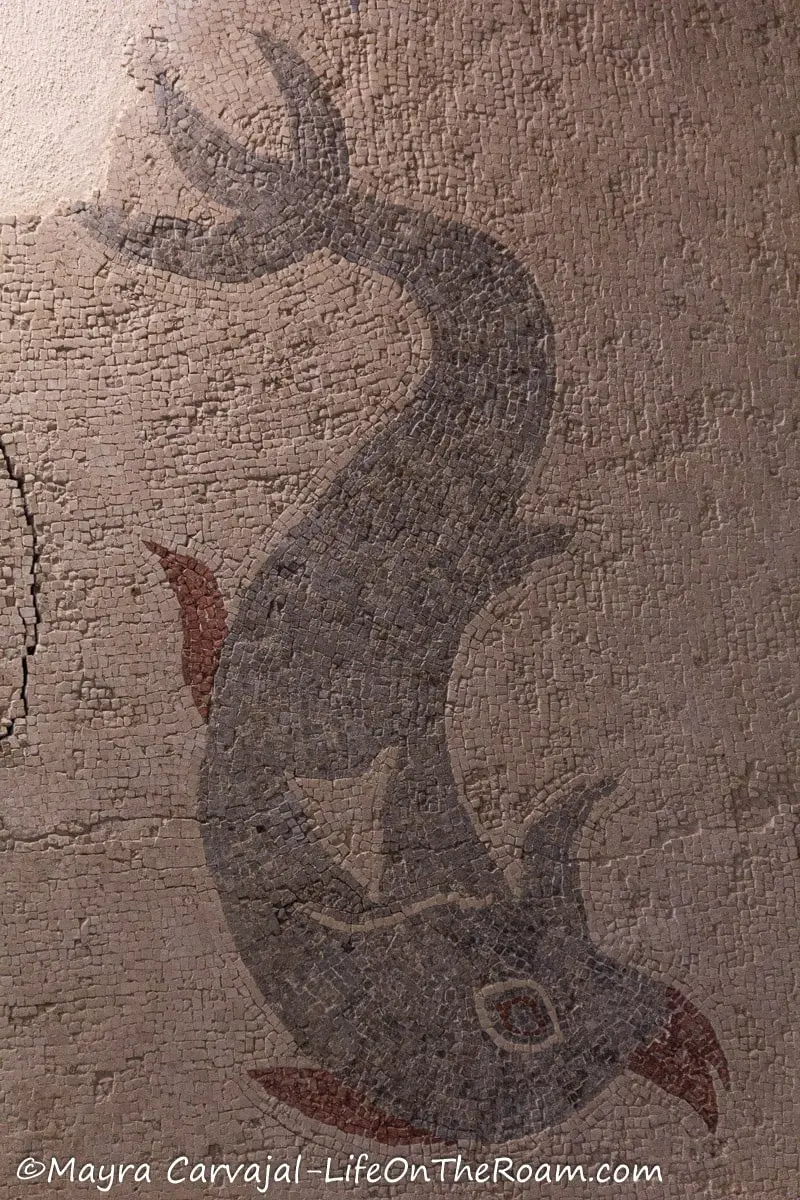
I loved these ancient glass vessels resembling amphoras.
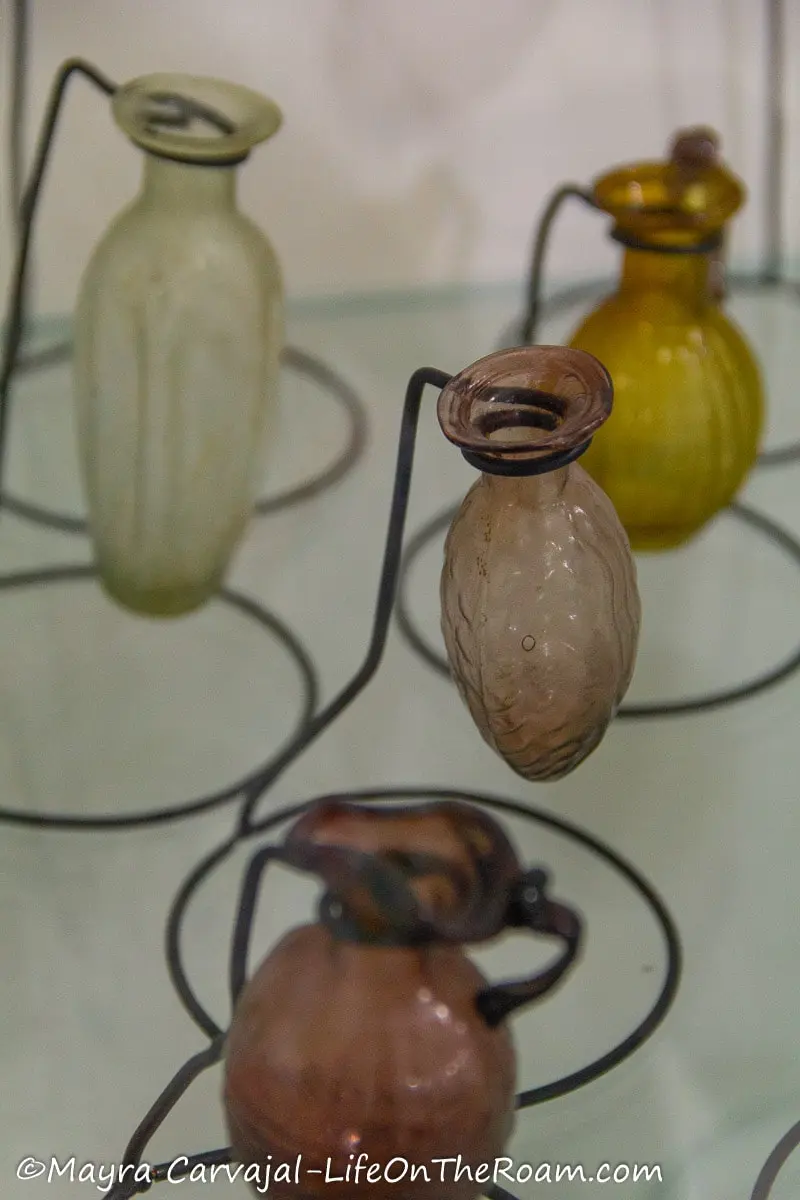
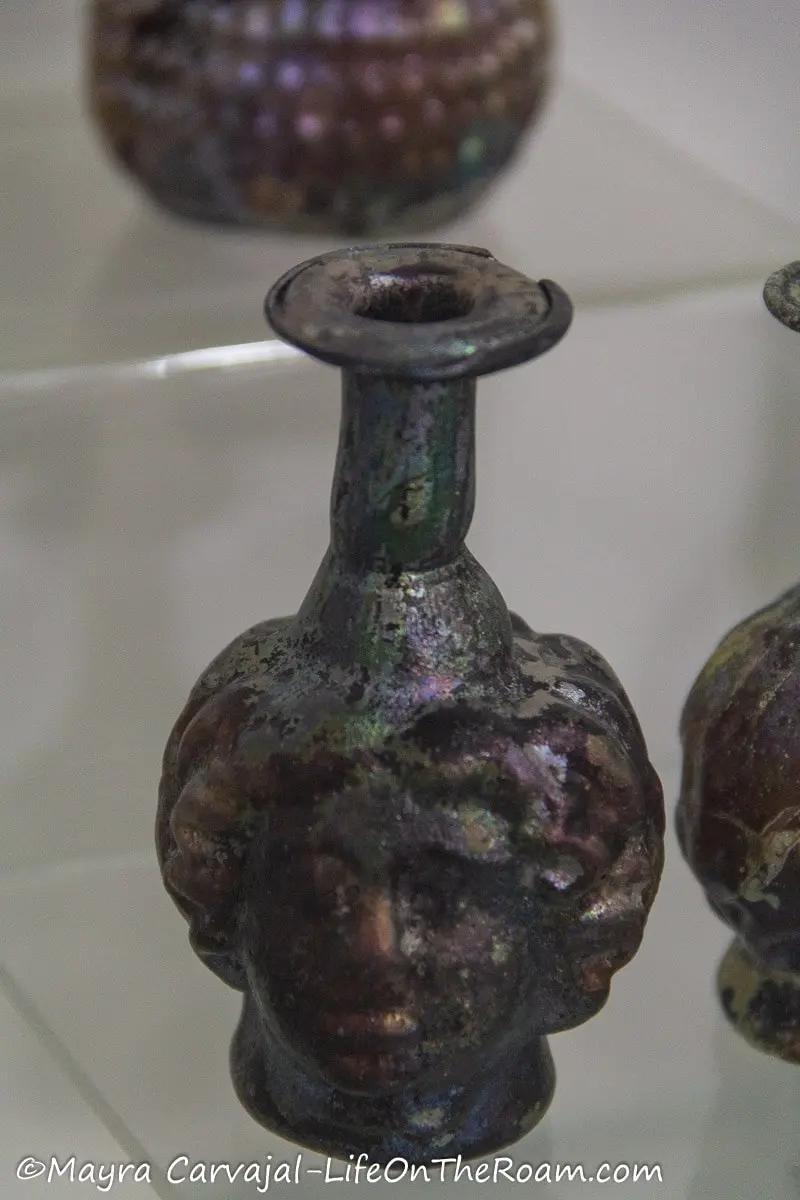
During excavations of the necropolis archaeologists recovered urns made of stone and glass from the Roman era, and some pottery pieces (1st-2nd century A.D.).

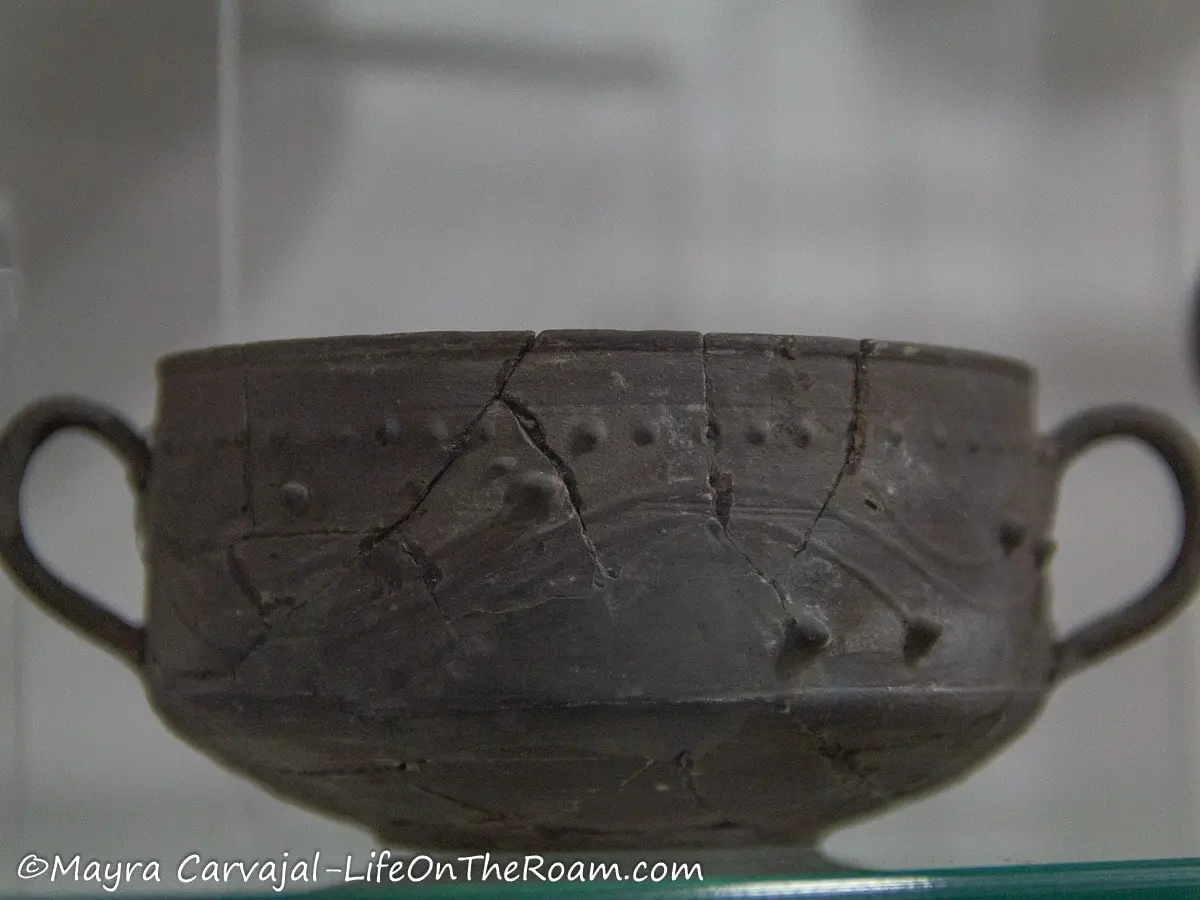
From the Byzantine Period (4th-6th century A.D.) you’ll find several architectural ornaments and capitals’ fragments.
Go to the third floor to fast forward several centuries as you enter the ethnographic collection area. You’ll learn about life in town and the rural areas of Budva before the conveniences of the modern era.
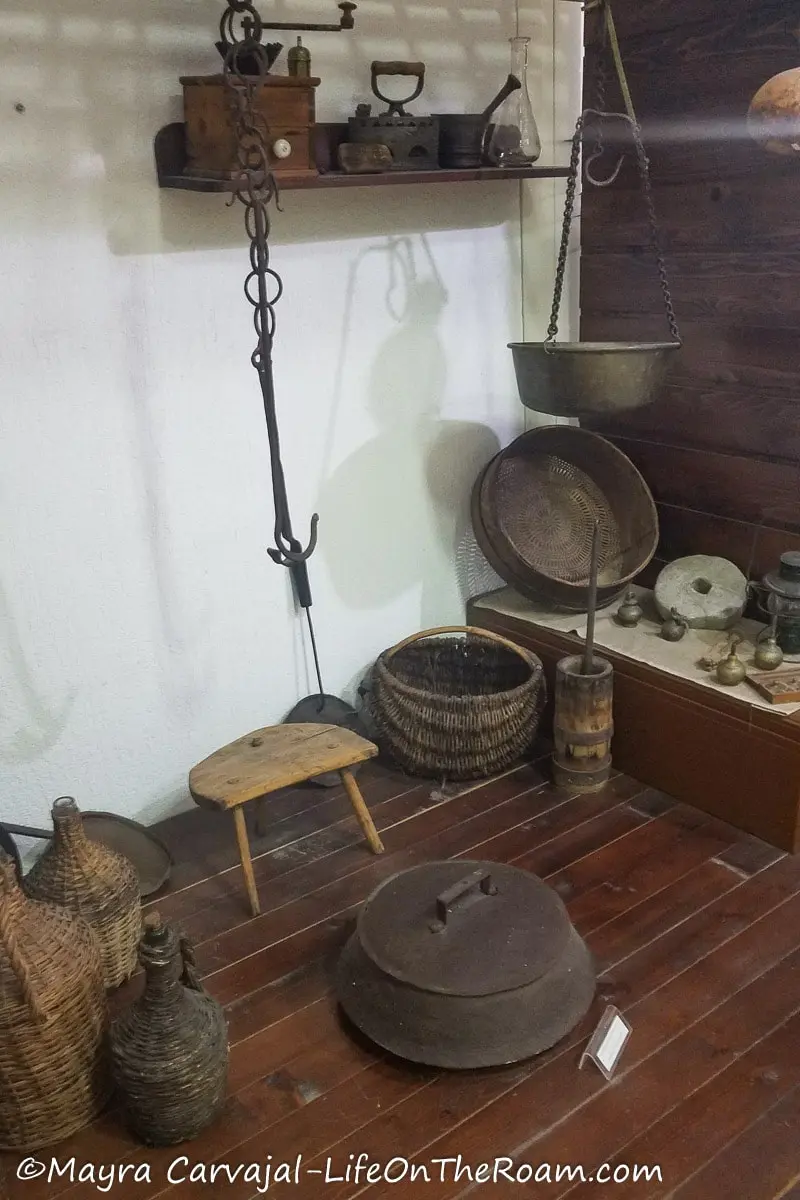
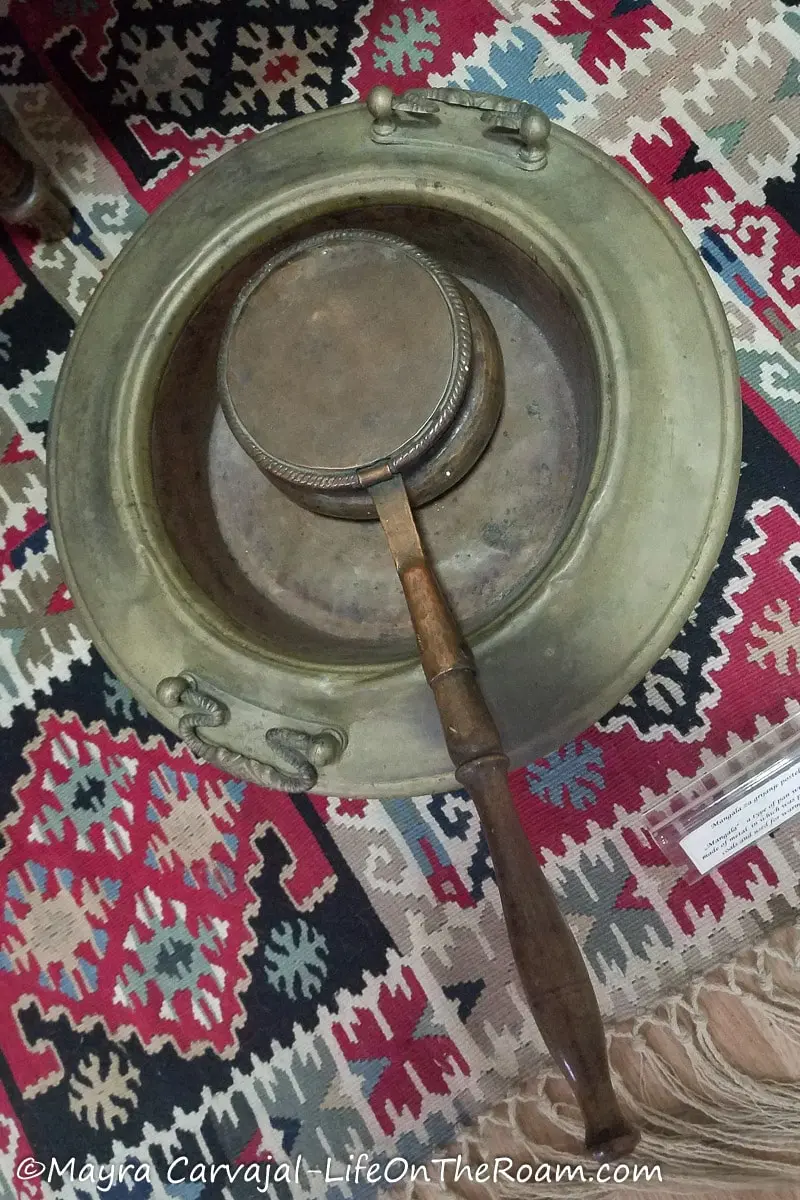
Thanks to its mountain and seaside location Budva has had a diverse economy relying on fishing, farming, and agriculture, including olive oil production. You’ll see tools and instruments, antique furnishings, and traditional costumes.
There are signs in English.
Open: Tue. to Fri.: 8AM-9PM.; Sat. & Sun.: 2PM-9PM; General admission: €3
Budva Old Town Churches
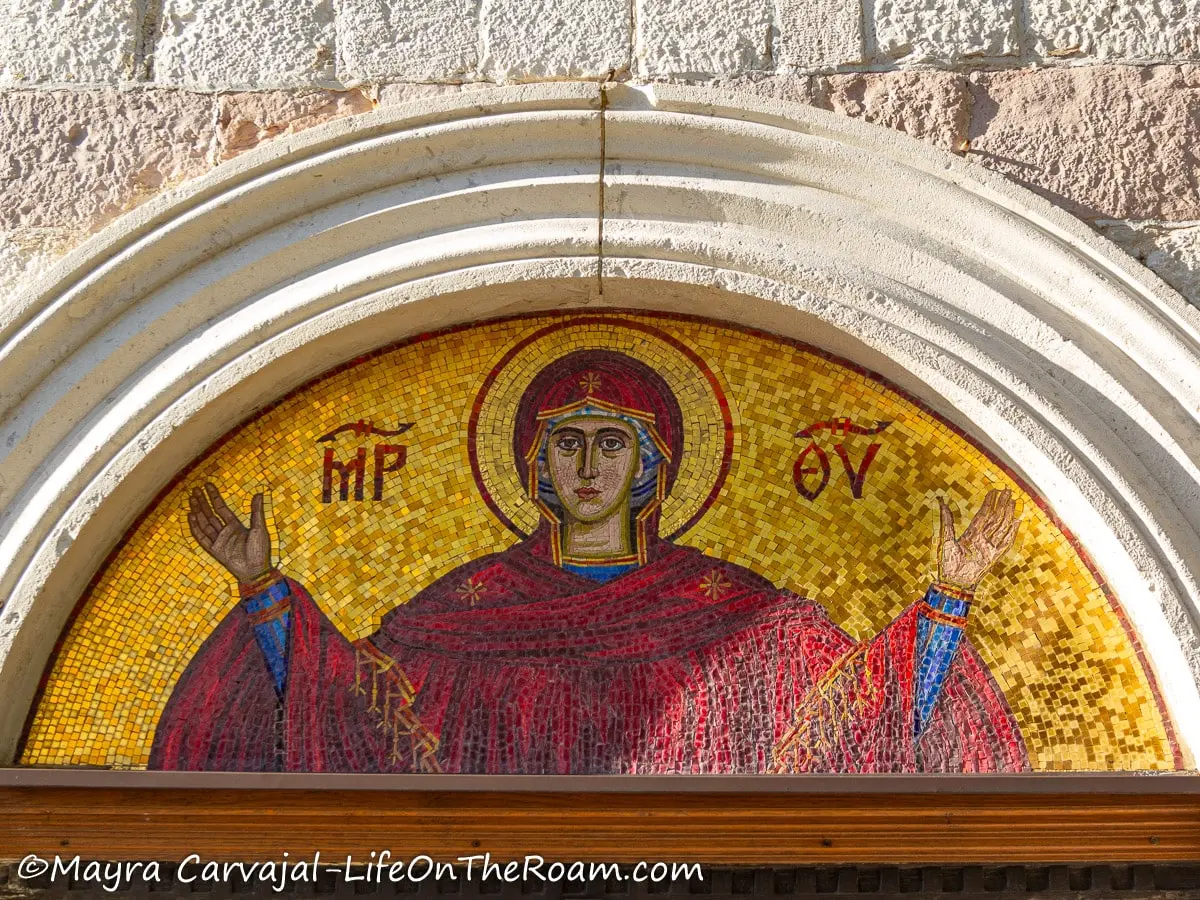
These are some of the medieval churches you can spot during your walk around the Old Town:
Church of St. John the Baptist
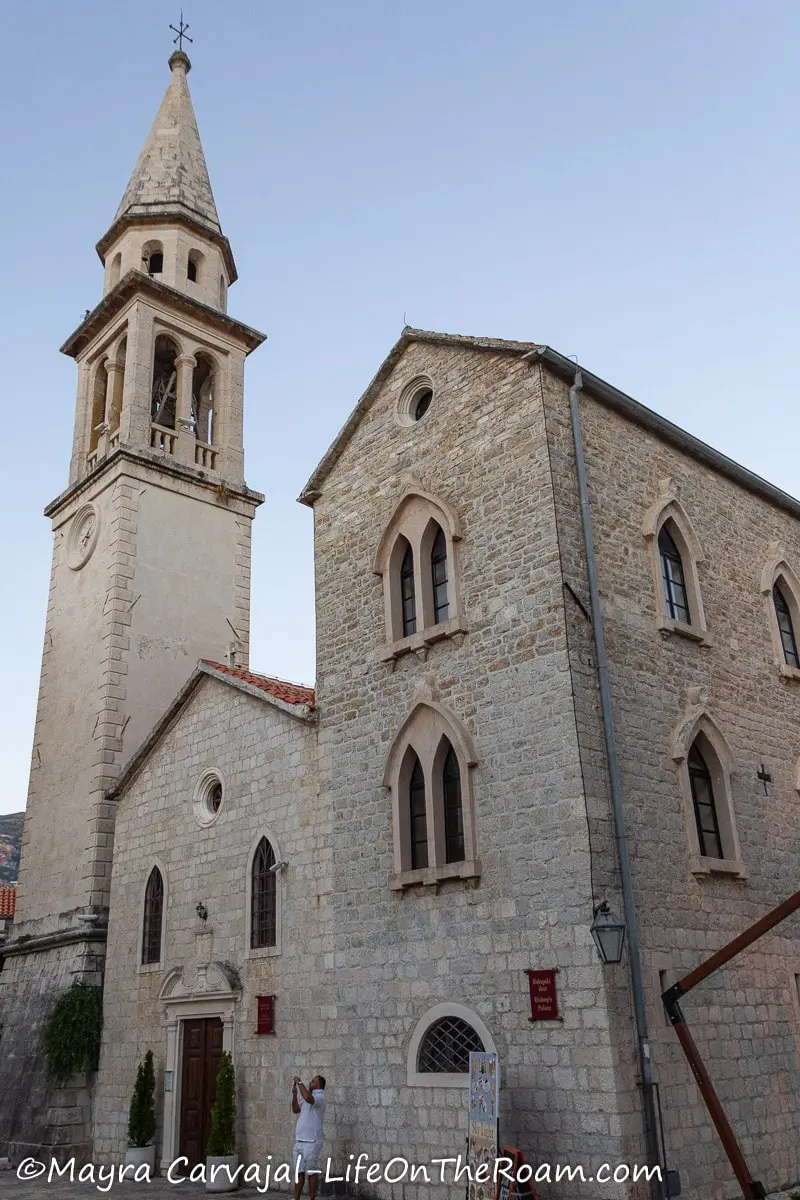
The original church stood here in the 7th century and underwent several major renovations. The last one happened in the 20th century.
Church of St. Sabba The Sanctified
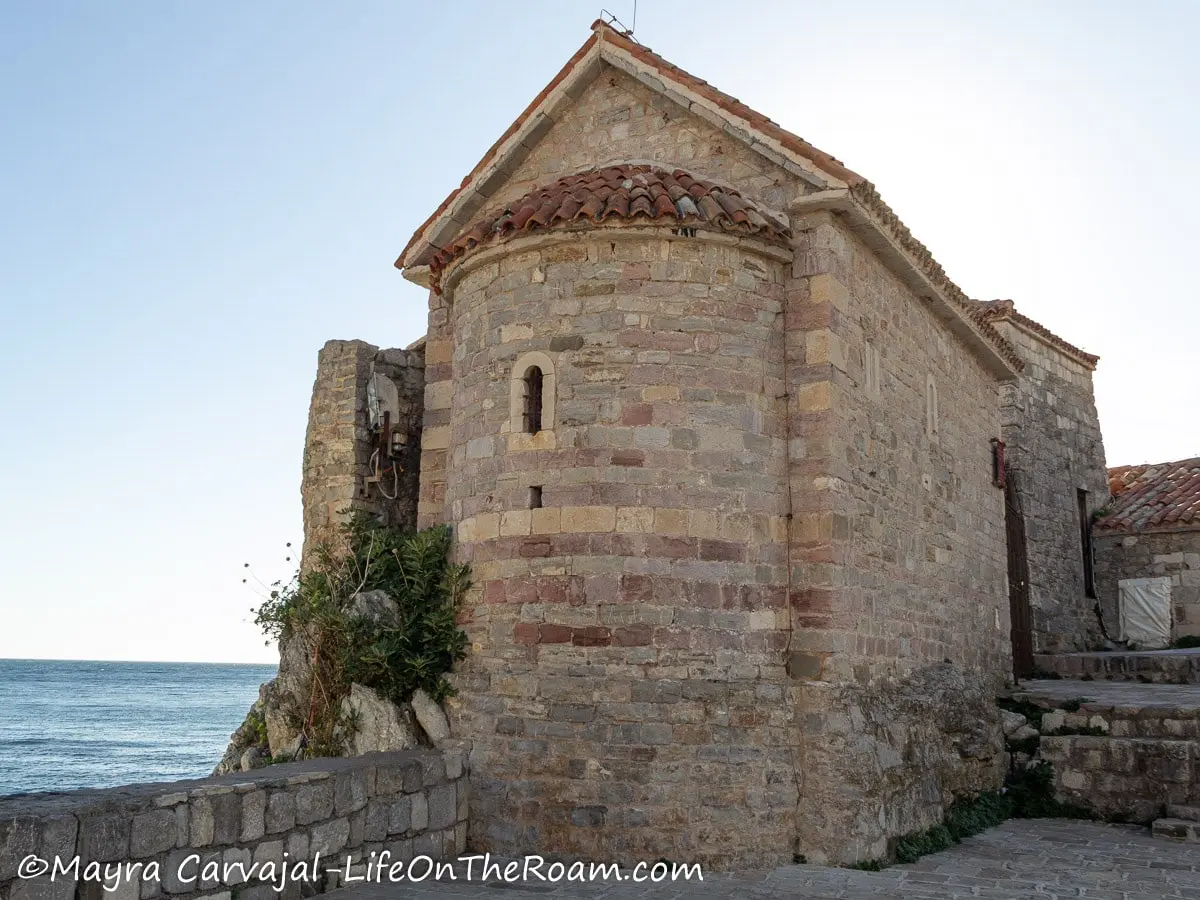
This is a church in Romanesque style, from the 12th century, where Catholic and Orthodox services took place during the Venetian period.
Church of The Holy Trinity

This pretty church, built in 1804, welcomes you with a colourful mosaic above the main entrance and with some impressive iconostasis and colourful, detailed interior murals with a deep blue background.
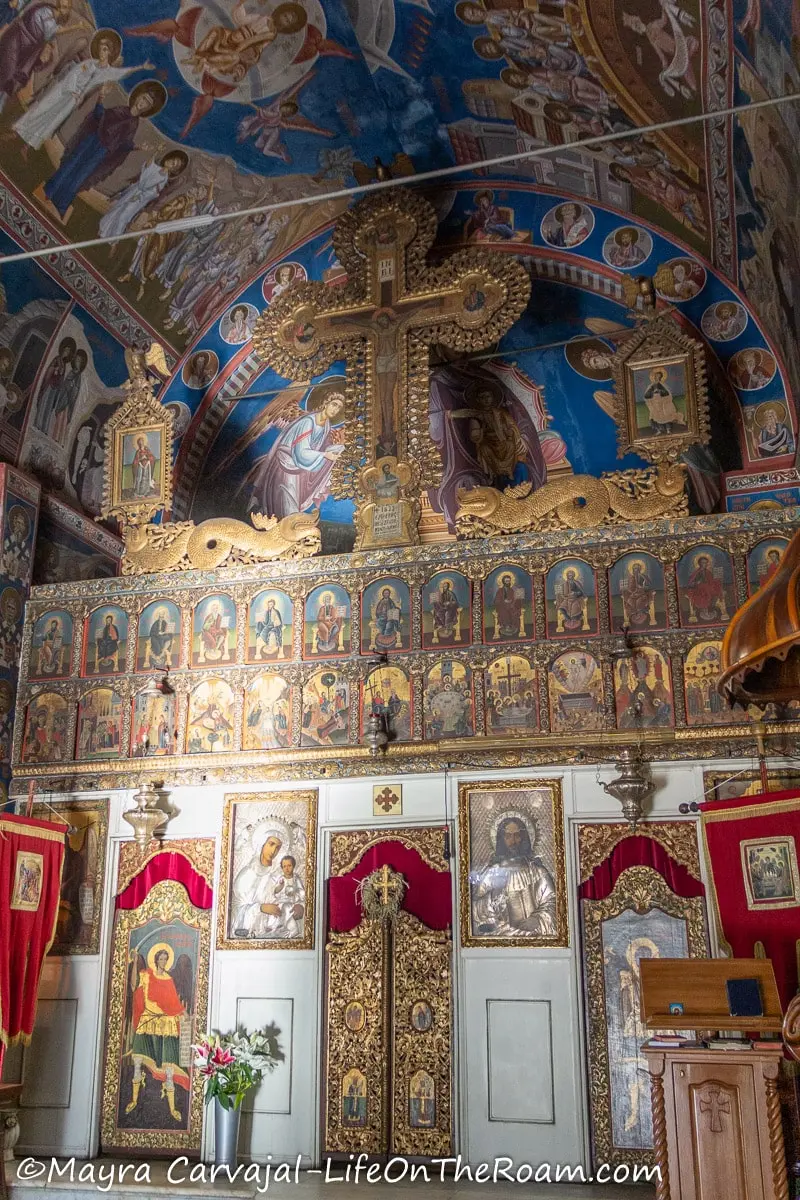


Church of Santa Maria in Punta
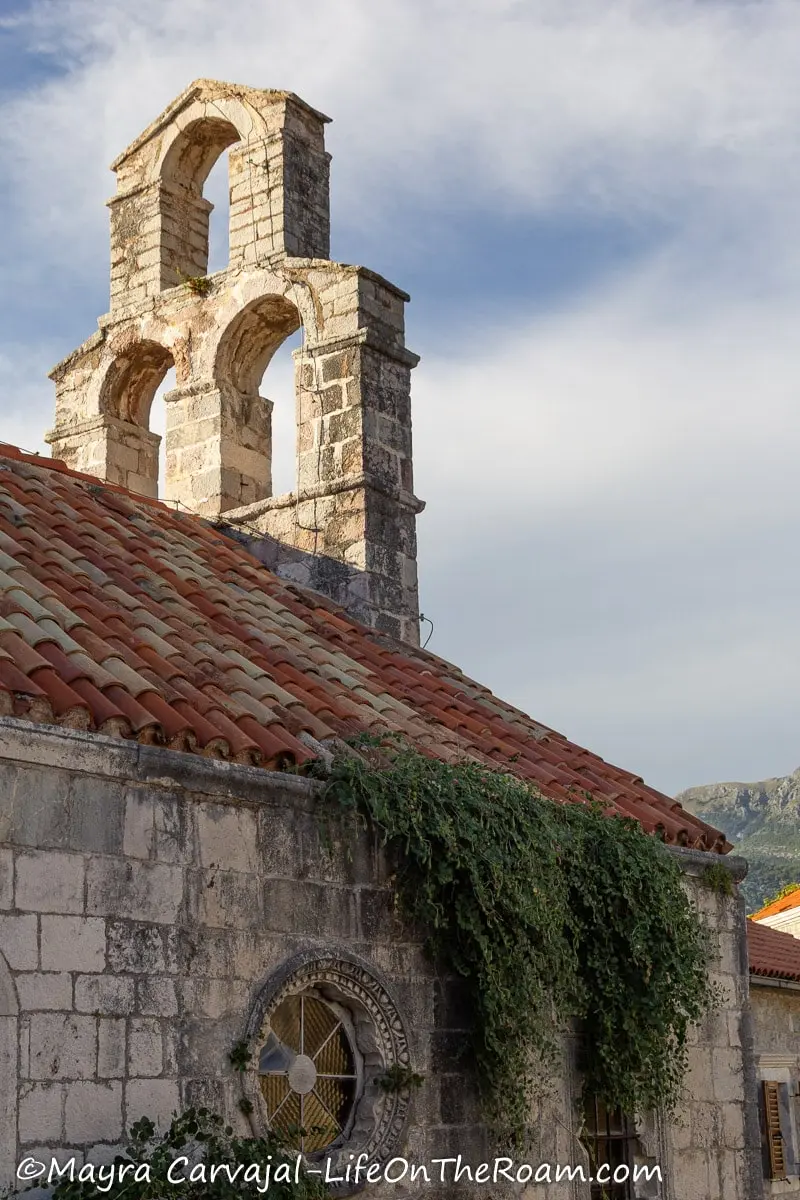
This is one of the oldest churches in the Adriatic coast, dating back to the 9th century.
Early Christian Basilica
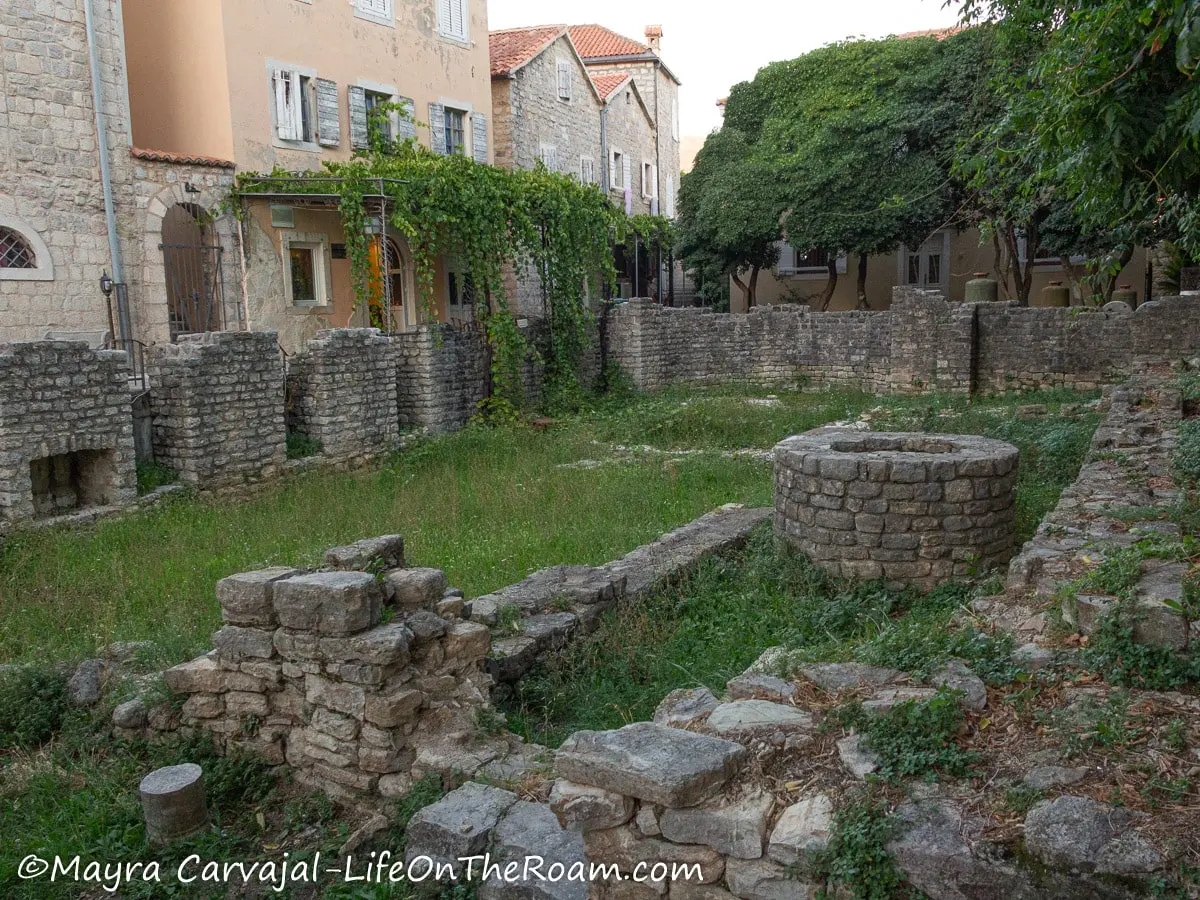
If you want to see the oldest church in town (or what’s left of it with growing weeds), check out the remains of this big basilica from the 5th-6th century A.D. where you can still see the apse at the end.
Budva Citadel
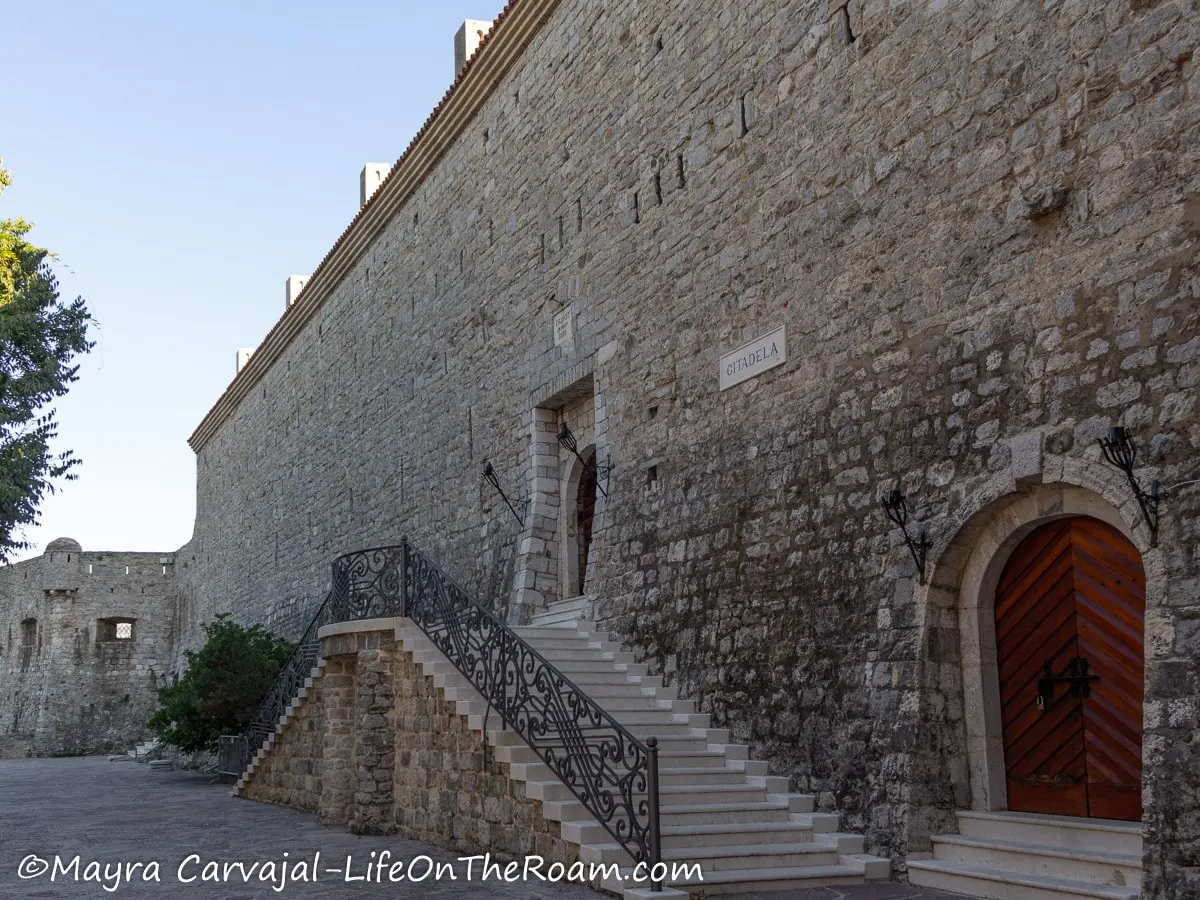
For centuries the Budva fortress, located on the south side of Old Town, protected its people from potential invaders. The first written mentions of the citadel date back to the 15th century, but archaeologists suspect that this was the site of an acropolis during ancient times.
Today, other than its historic significance, it’s all about the terrific views of the Old Town, Sveti Nikola Island, and the Budva Riviera from its elevated terraces.



There’s a small, nice but far from spectacular library with historic books, a wall display of old maps and journals, and a handful of highly detailed model sailing ships (it’s called a “Museum”, but that’s a stretch).
You can see the remains of the Church of Santa Maria di Castello (12-14th century), even though there’s not much to see as it was engulfed by a fort built during the Austrian occupation. You’ll also find the “Symbol of Budva”.
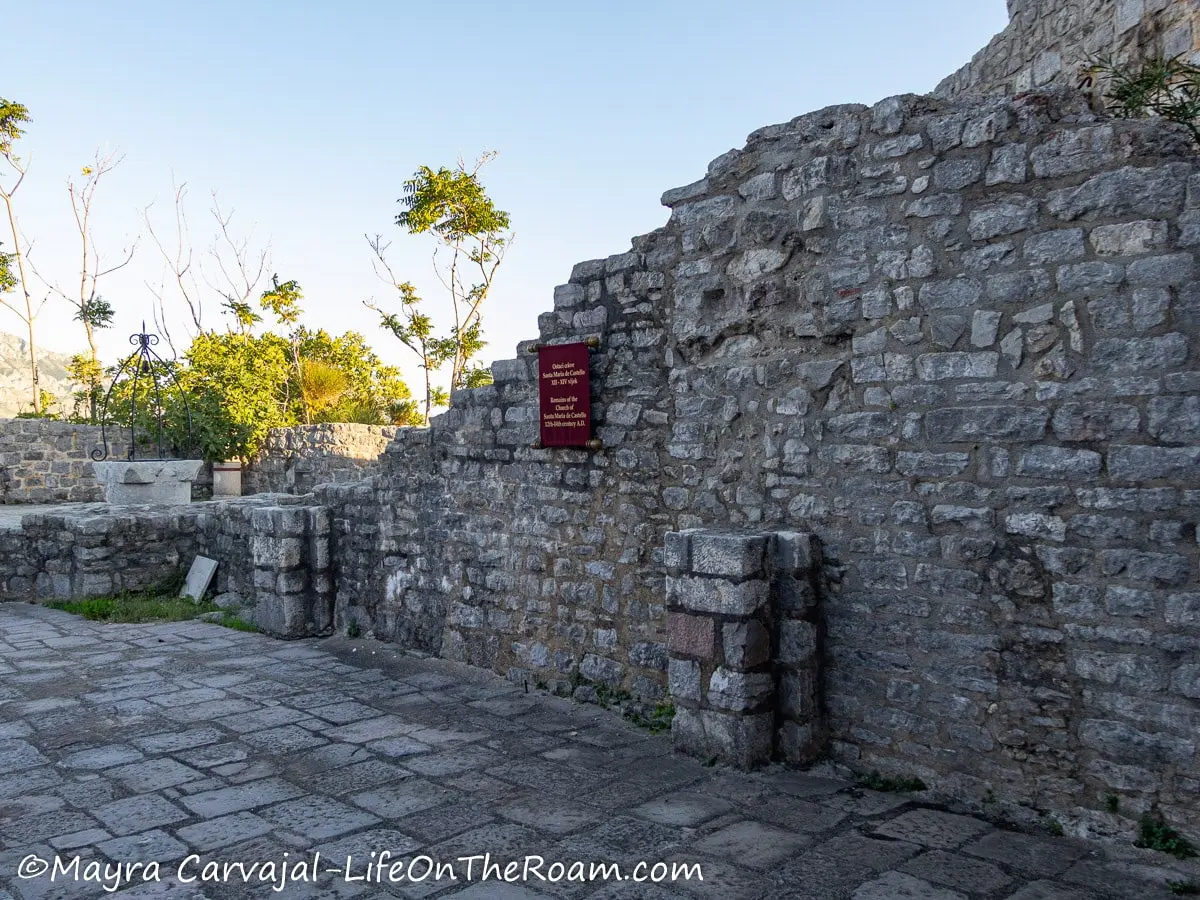
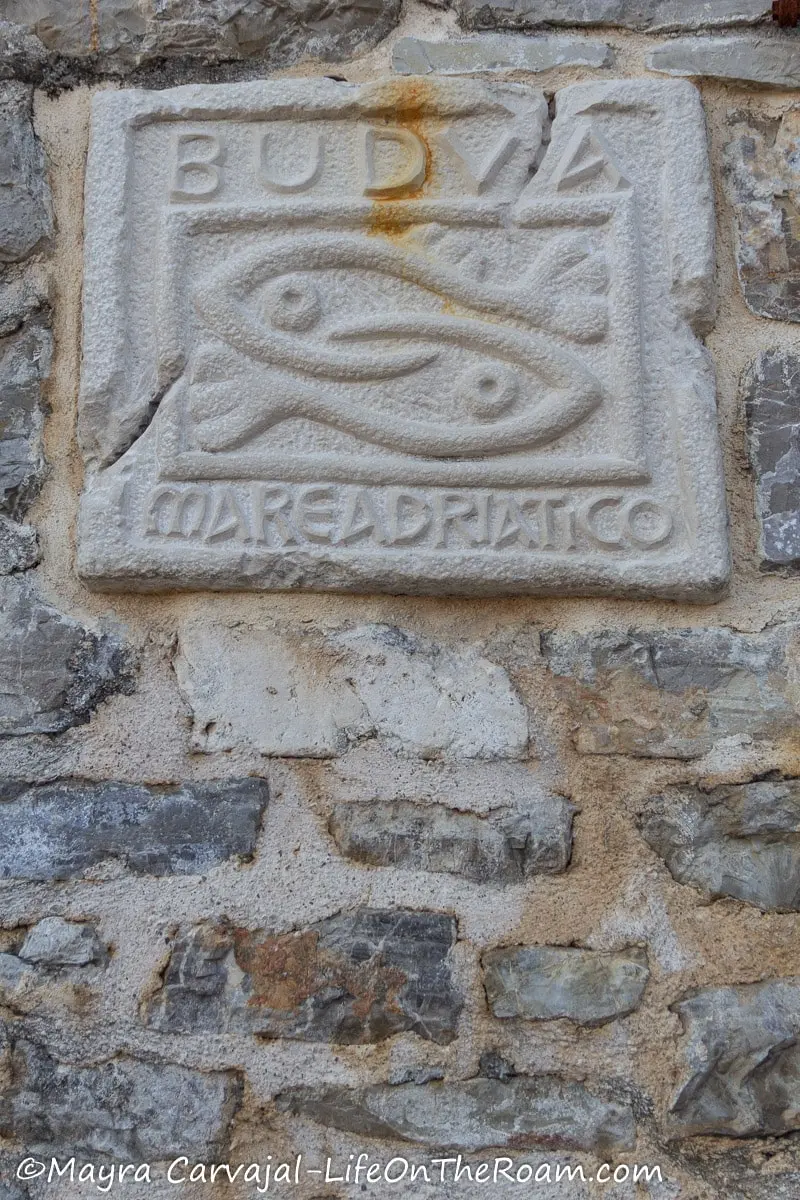
There’s also a restaurant, on the expensive side.
Like I said before, the main attraction is the panoramic view and that’s pretty much it. If you come as a family it can become an expensive view as the entrance fee is €5.5p/p.
Modern Art Gallery Jovo Ivanović
In the middle of the sea of history that is Old Town Budva there’s also space for modern art. During your visit take some time to check out the work of contemporary artists (I loved the exhibit that was up during my time here). If you’re in luck you may be able to catch a concert or performance in the gallery.
Budva Dancing Girl
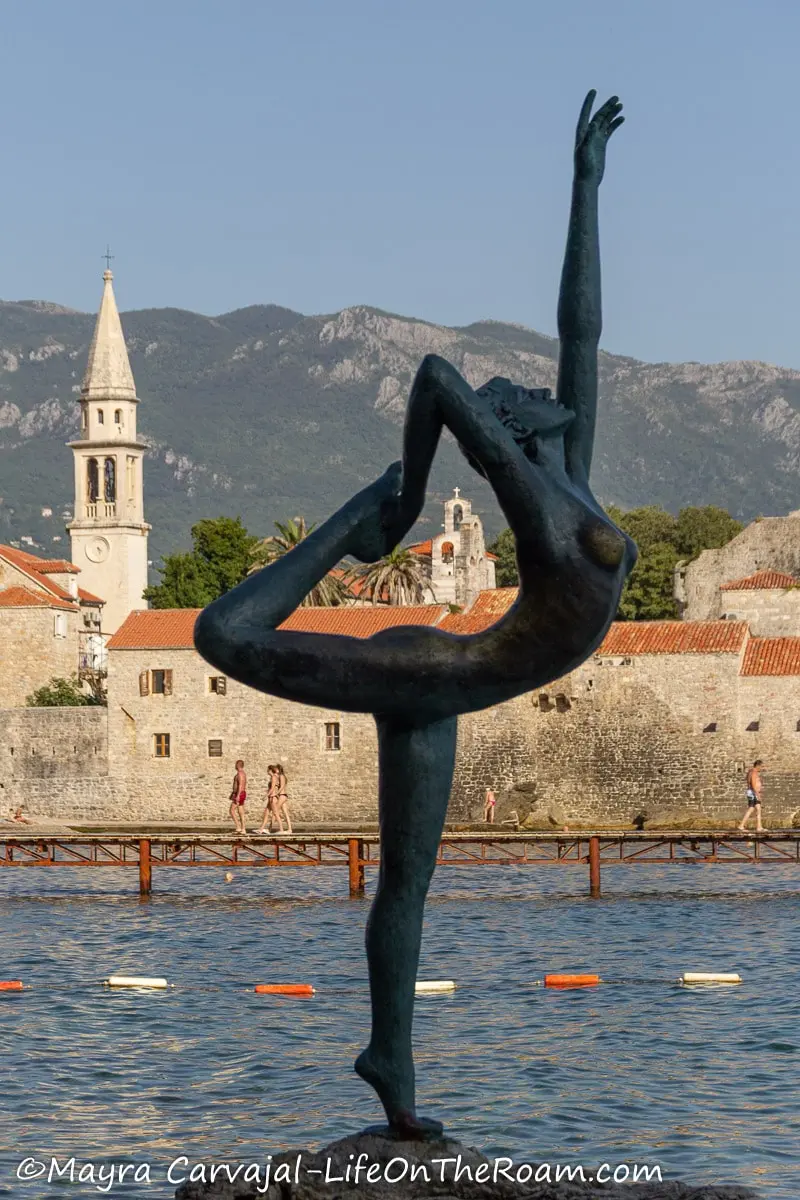
This famous city landmark, also known as the Budva Ballerina and the Gymnast of Budva, is an iconic bronze statue located on the seaside promenade that takes you from the vicinity of Old Town to Mogren Beach.
It’s the work of sculptor Gradimir Aleksić, who created it inspired by a legend, or should I say, legends.
One speaks about a girl who died sad, tired of wanting the return of the sailor she fell in love with, and one speaks about a girl who went swimming in the ocean and drowned.
I don’t know which one he heard, but it certainly inspired a beautiful statue and many Insta pictures.
Paragliding
One of the elements that make Budva a special place is its sinuous coastline, shaped by towering green mountains descending into the blue waters of the Adriatic Sea.
If you’re looking for an adventure, you can try paragliding and see Budva’s landscape from the air.
Budva Paragliding Experience: enjoy an aerial view of Budva as you glide in the sky on a tandem flight with an experienced guide.
Book your tandem paragliding flight, with a rating of 4.7/5 based on more than 70 reviews.
Beaches near Old Town Budva
Ričardova Glava Beach (Brijeg od Budve)

A small, pebbly beach right outside the walls of Old Town Budva as a historic backdrop.
The downside is that being so small, easily accessible, and with a bar and restaurant right there it gets crowded, the charge for beach loungers can go up to €50, and at times trash accumulates.
Mogren Beach (I and II)
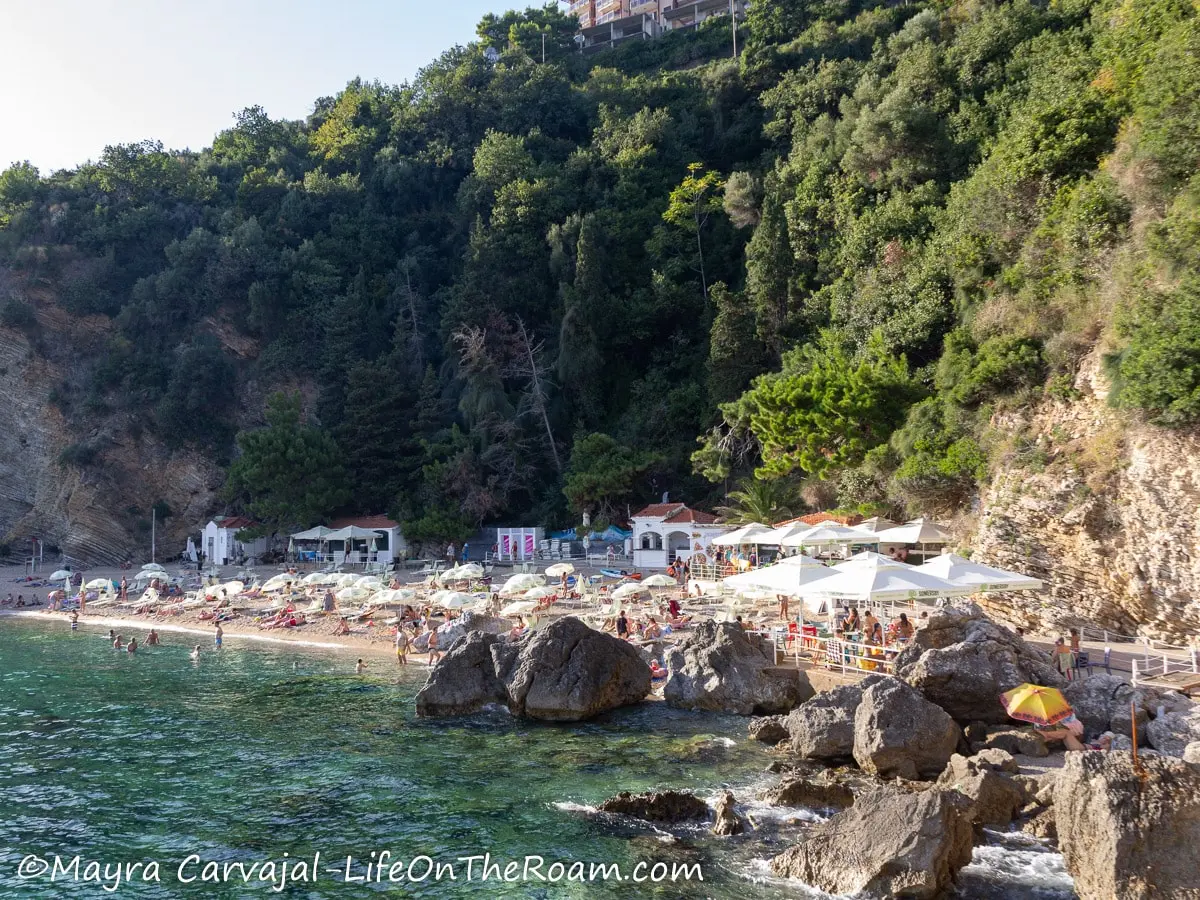
Mogren is my favourite beach of all the ones that are close to the Old Town. Clear water, sandy shore, and with enough space available to lay a towel in case you don’t want to rent beach loungers.
There’s a bar on site, showers, and changing stalls.
Another big win is the scenery, with big horizontally and diagonally layered rocks framing the beach. Take a walk along the scenic coastal path that leads to this site, even if you’re not planning to go in the water.
You’ll step on walkways that embrace the mountain and go through natural rock passages where you’ll see some gorgeous and interesting formations.
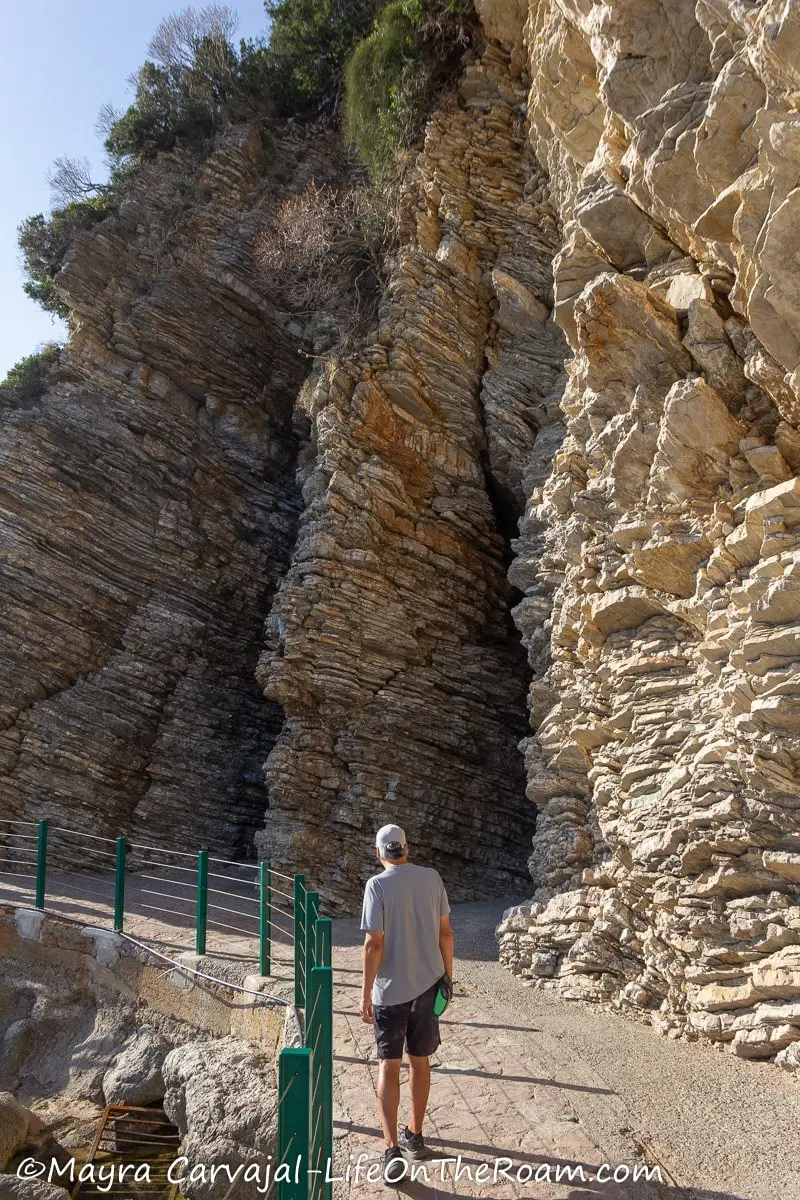
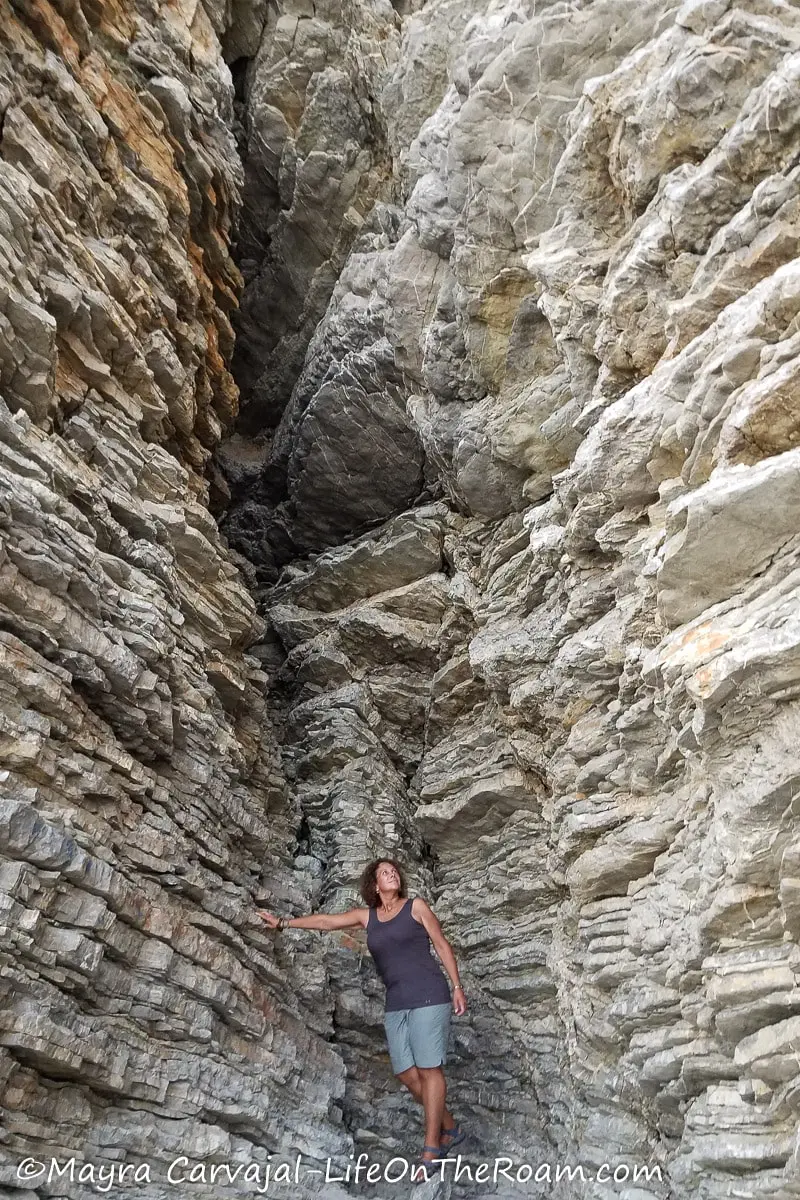
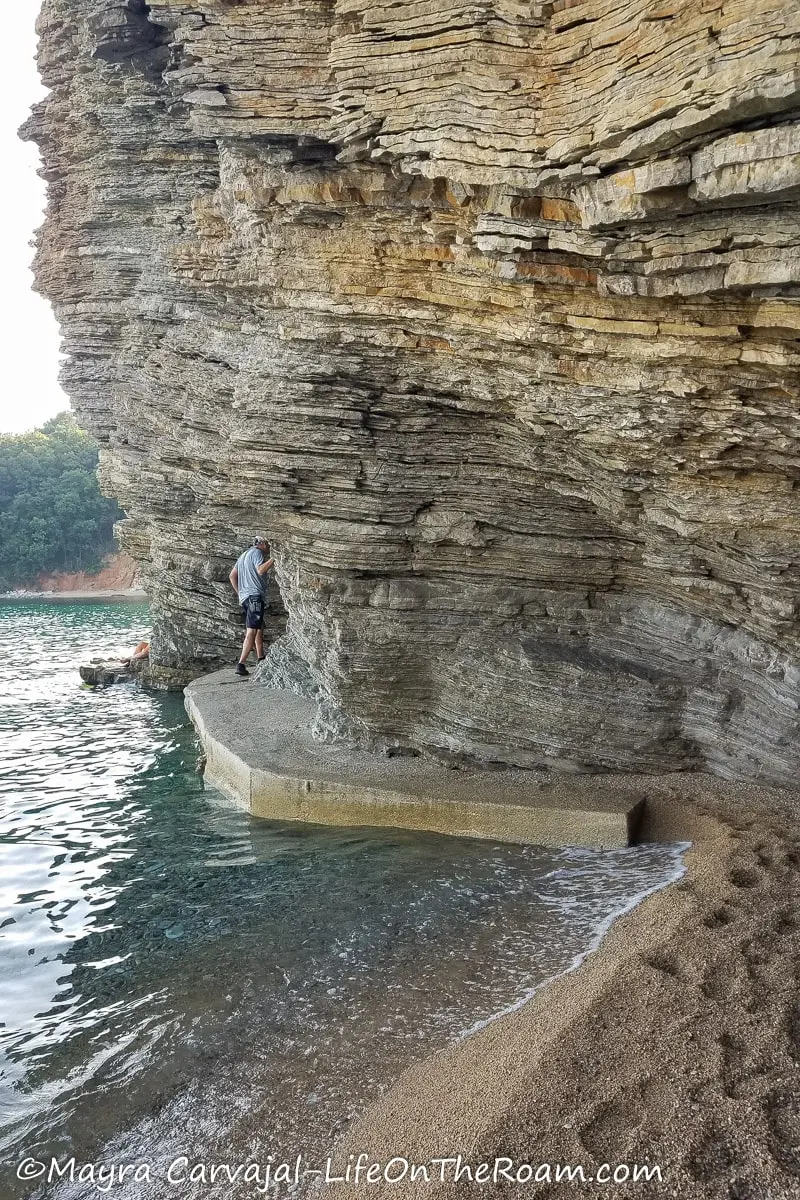
One of these passages connects Mogren I and II. This sandy beach also offers an excellent viewpoint of Sveti Nikola Island and the Dinaric Alps in the background.
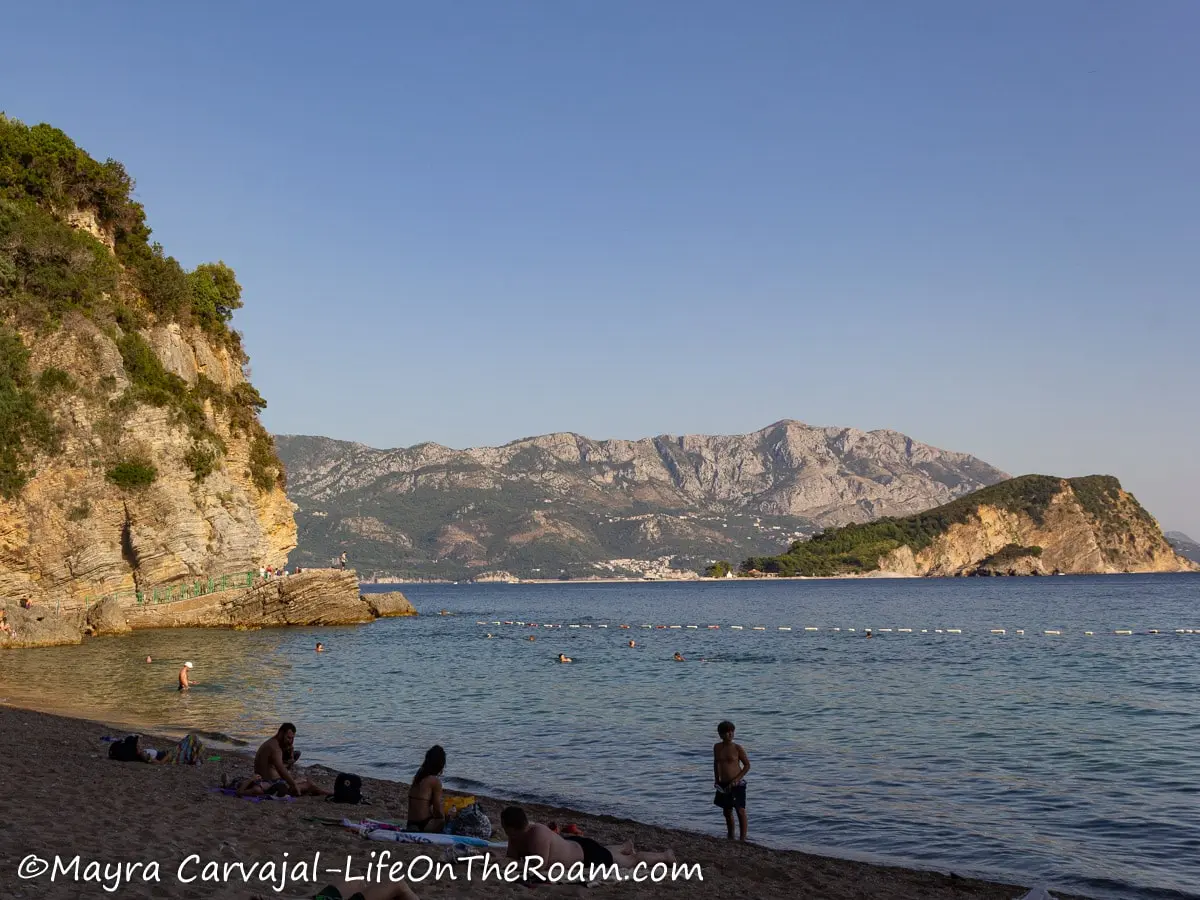
We walked all the way to the end of Mogren II and ventured out on the rocks a little bit to enjoy more fantastic views of the island and Old Town at sunset. I loved the violet tones in the sky.
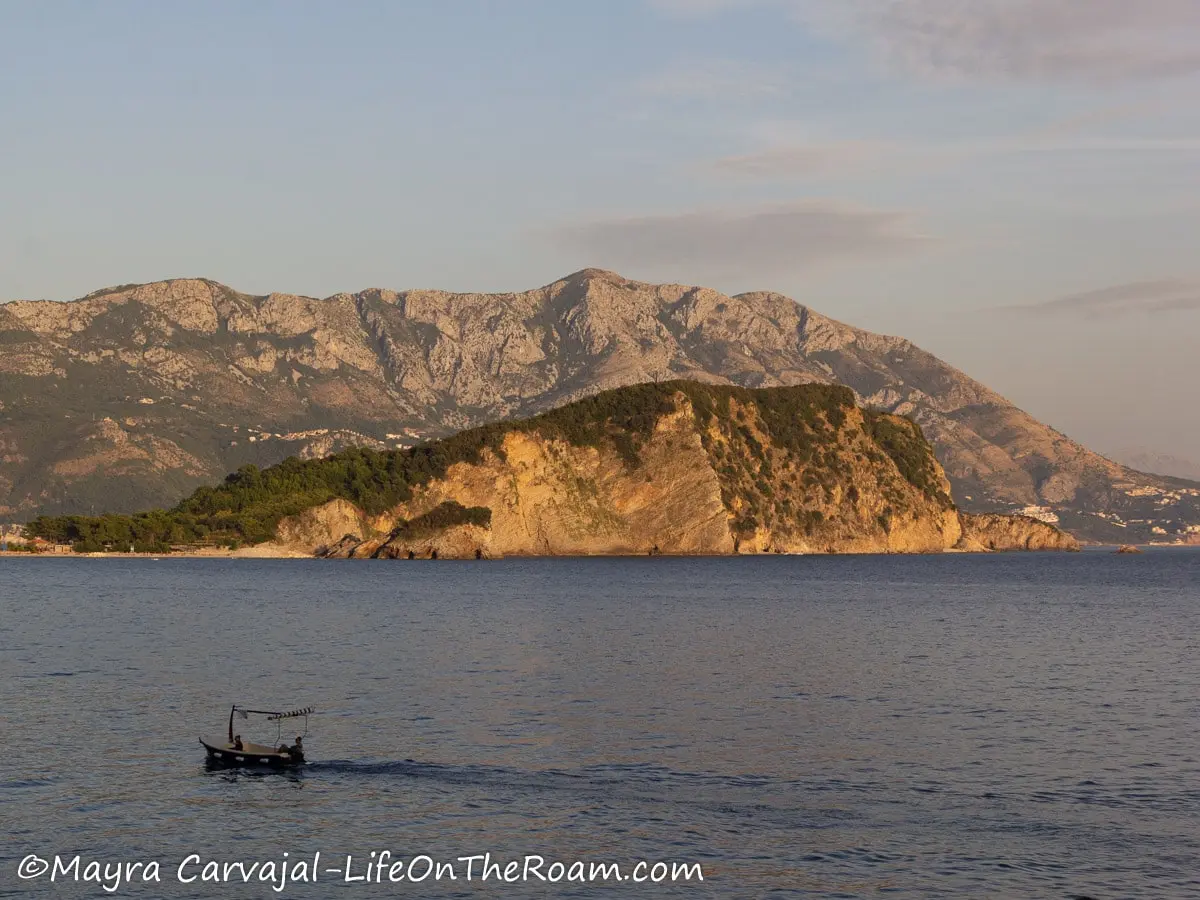

If you’re here during the high season it’s better to arrive early in the morning.
3-Hour Paddle Board or Kayak Tour to Coastal Caves: departing from Old Town, explore other nearby beaches and caves that are better reached or only reachable from the sea while you delight in Budva’s rugged coastline. Snorkeling gear and dry bag included.
Book this guided tour, with a rating of 4.8/5 based on more than 305 reviews.
Podmaine Monastery
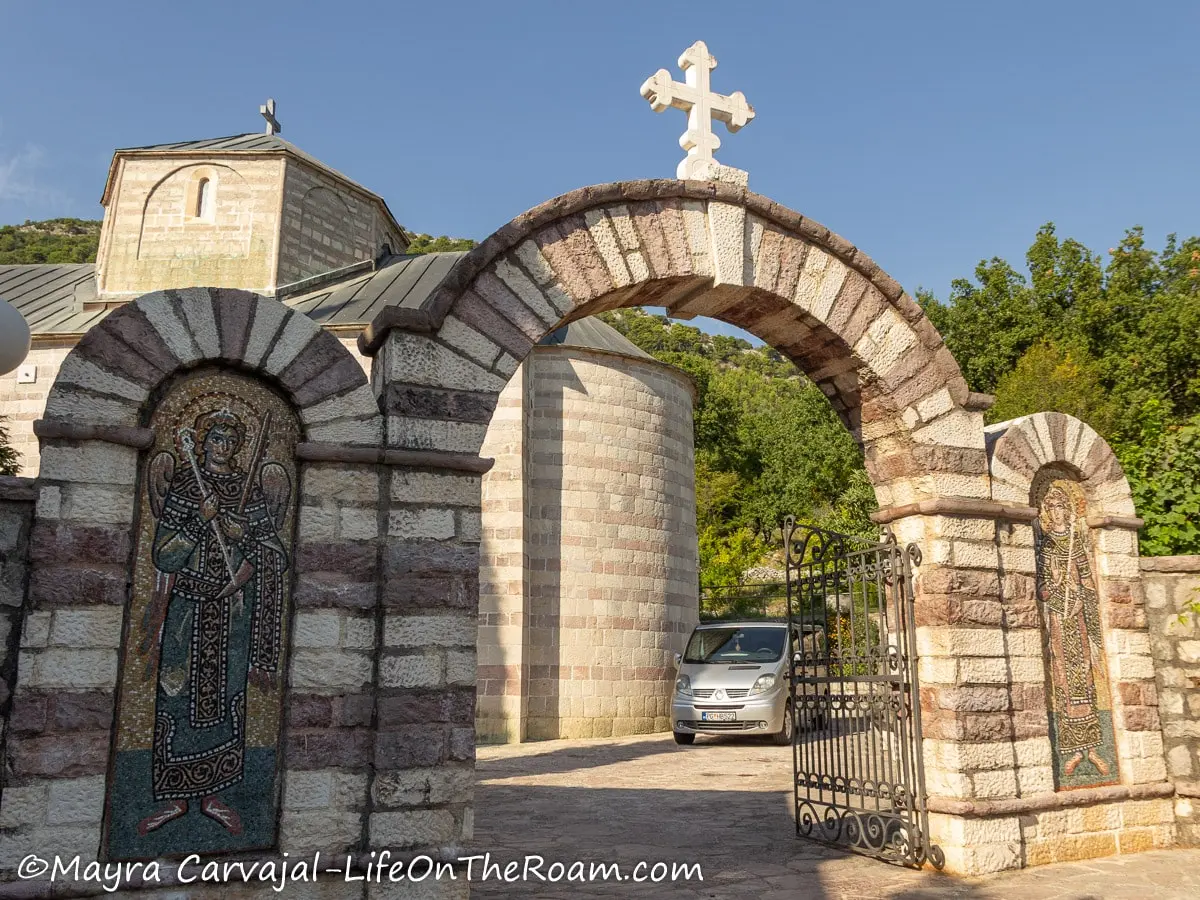
Visiting this Serbian Orthodox monastery from the 15th century is well worth the 30 to 40 minutes uphill walk from downtown Budva.
However, what you’ll see isn’t the original building as that one was destroyed by the 1979 earthquake. The one standing today is a reconstruction, with a huge round chandelier and new frescoes adorning its walls. They’re quite colourful and I thoroughly enjoyed looking at the many details.


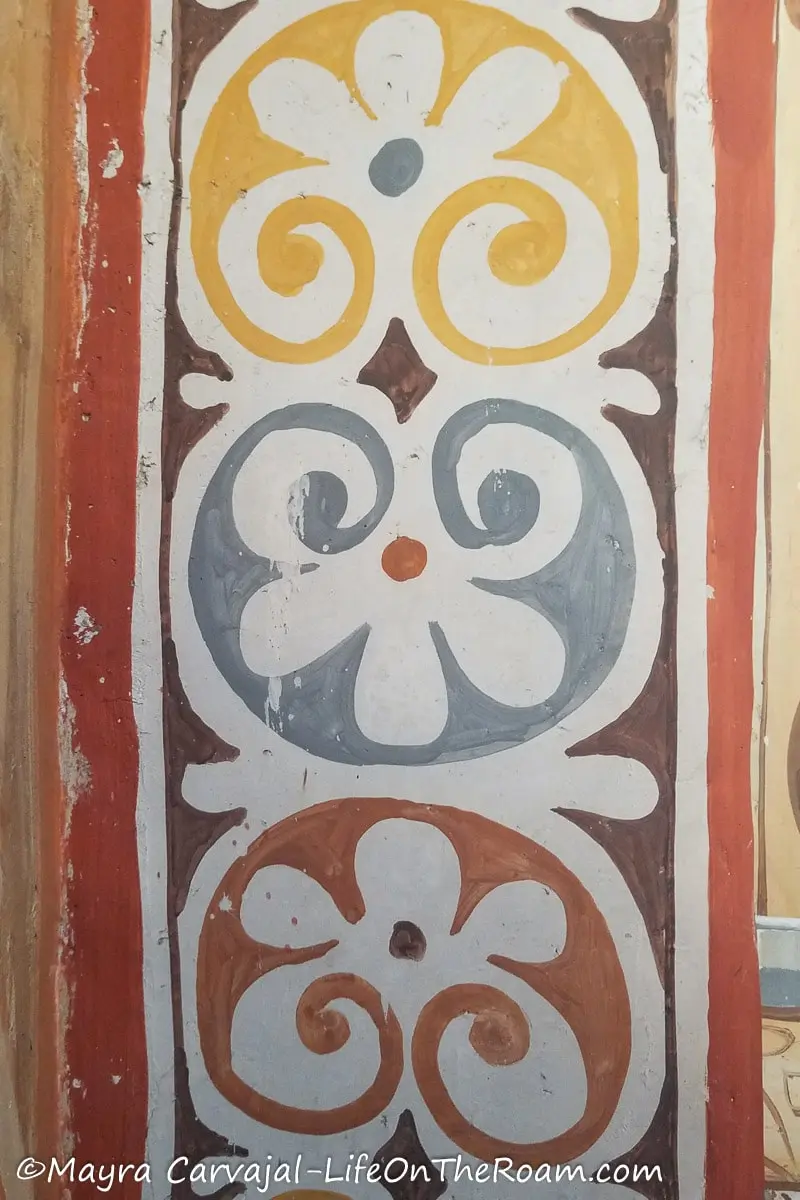
Take some time to check the various stone and glass mosaics. There’s also a small souvenir shop.
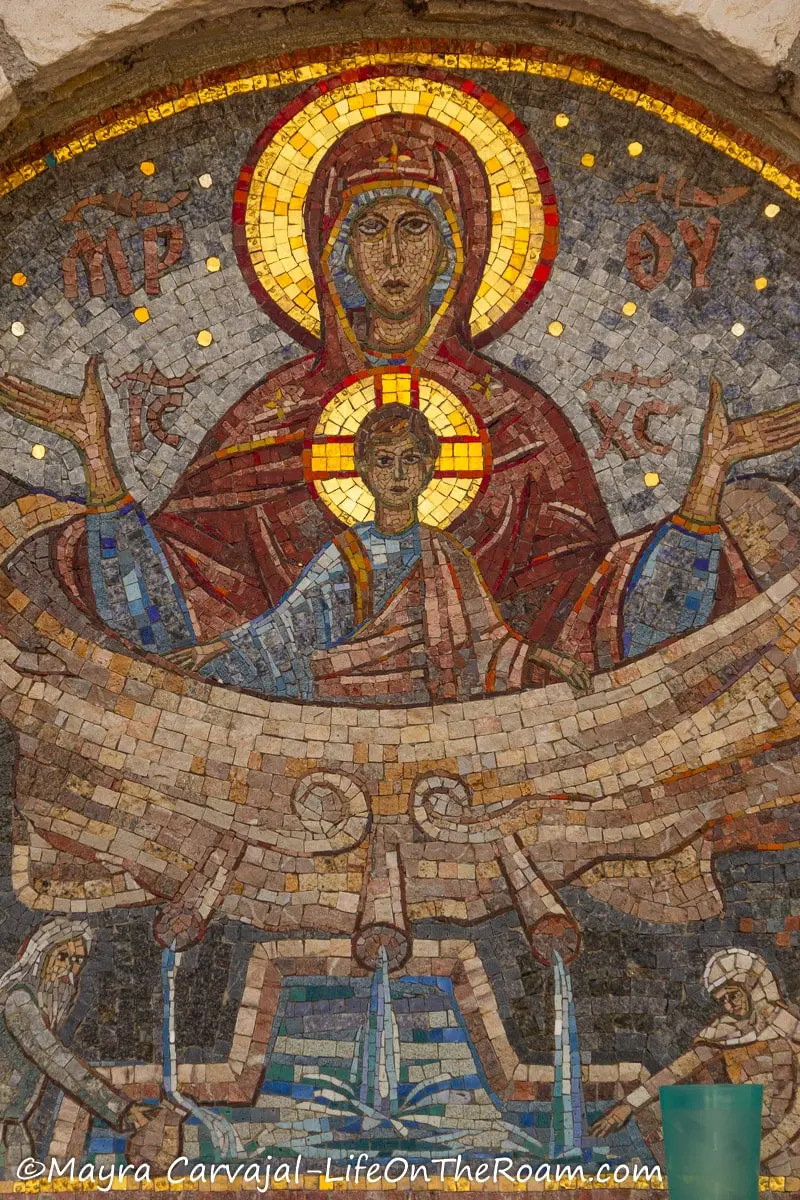

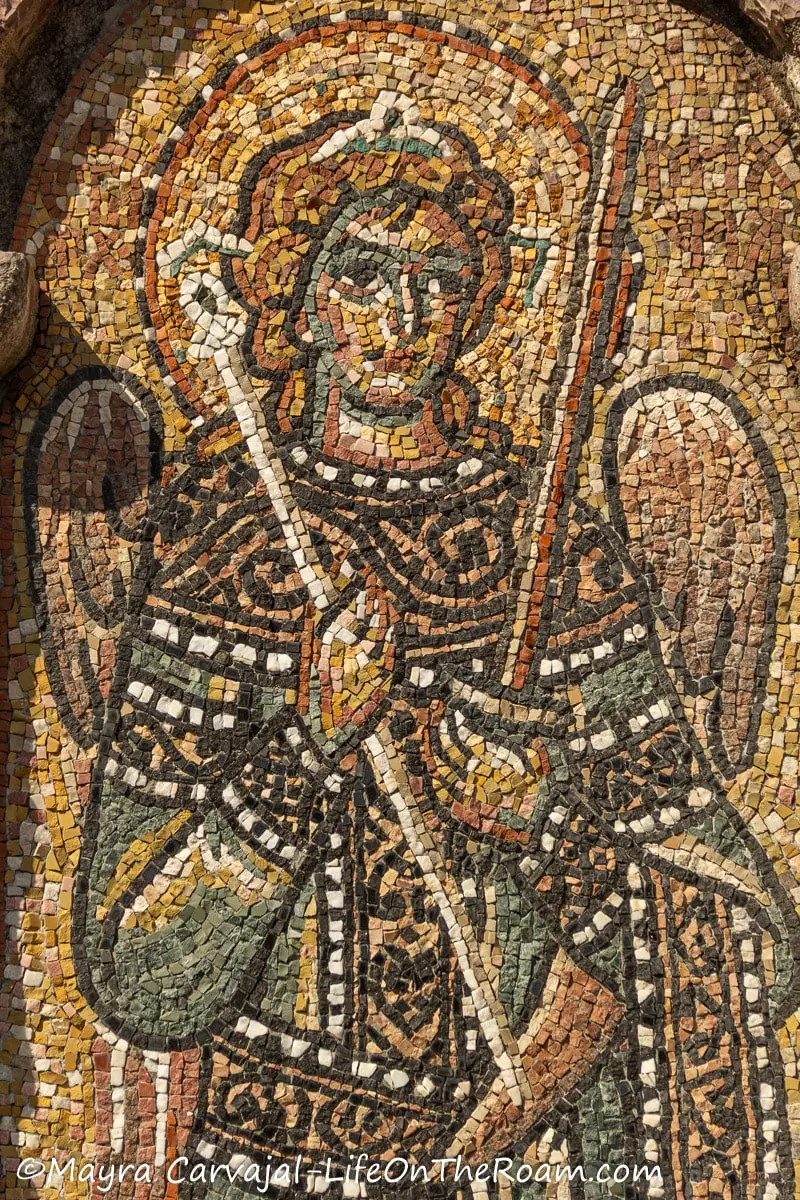
Want to see the most visited monastery in the Balkans? Check out the Ostrog Monastery, a sacred pilgrimage site right here in Montenegro.
Take this tour from Budva to Durmitor, Tara & Ostrog Monastery, with a rating of 4.8/5 based on more than 1,320 reviews.
Budva Beaches: Walking the Seven Bay Trail
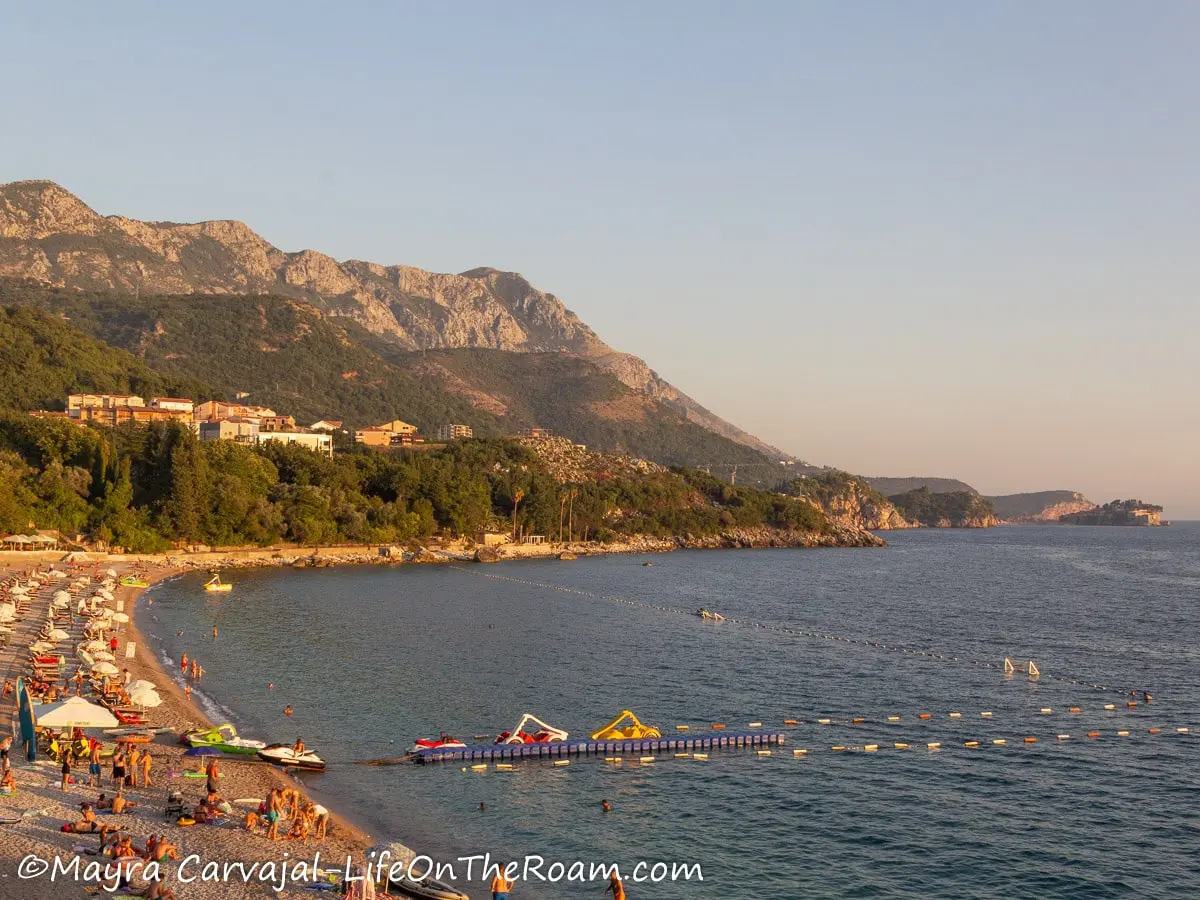
Budva is blessed with many scenic beaches, some better than others depending on the experience you’re after. The Seven Bay Trail connects them via an easy coastal path -mostly paved- that you can walk in a few hours. Less than three if you don’t stop at the beaches (please do).
As a general rule, if you visit during the summer you’ll find yourself surrounded by a sea of people and, unfortunately, with the trash that it’s left behind.
You’ll have a better experience and find lower rates if you visit during the shoulder season. Mid- September is a good time, when the summer rush is over and it’s still warm without being stifling.
We took the bus from Budva to Sveti Stefan and walked back towards downtown Budva, visiting all the stops in between. Here I share with you how to get from one beach to the next and where to go to find the best spots and viewpoints so you can make your own itinerary or visit them all.
I also included a map listing the beaches.
Sveti Stefan

Meet the star of dreamy pictures of the Budva Riviera, featuring a red and beige pebbly beach in a curve ending at a 15th century fortress built on an islet.
We reached this world-famous destination by taking the public bus from the Budva bus station, hopping off at the Sveti Stefan stop located on the main road above the hill. After walking a few meters down the windy road we found the stairs that lead to the beach (look for the Plaža signs).
The beach has a gentle slope with crystal-clear water reaching the shore with gentle waves, and the iconic view of the old-town-turned-resort with mountains in the far distance.
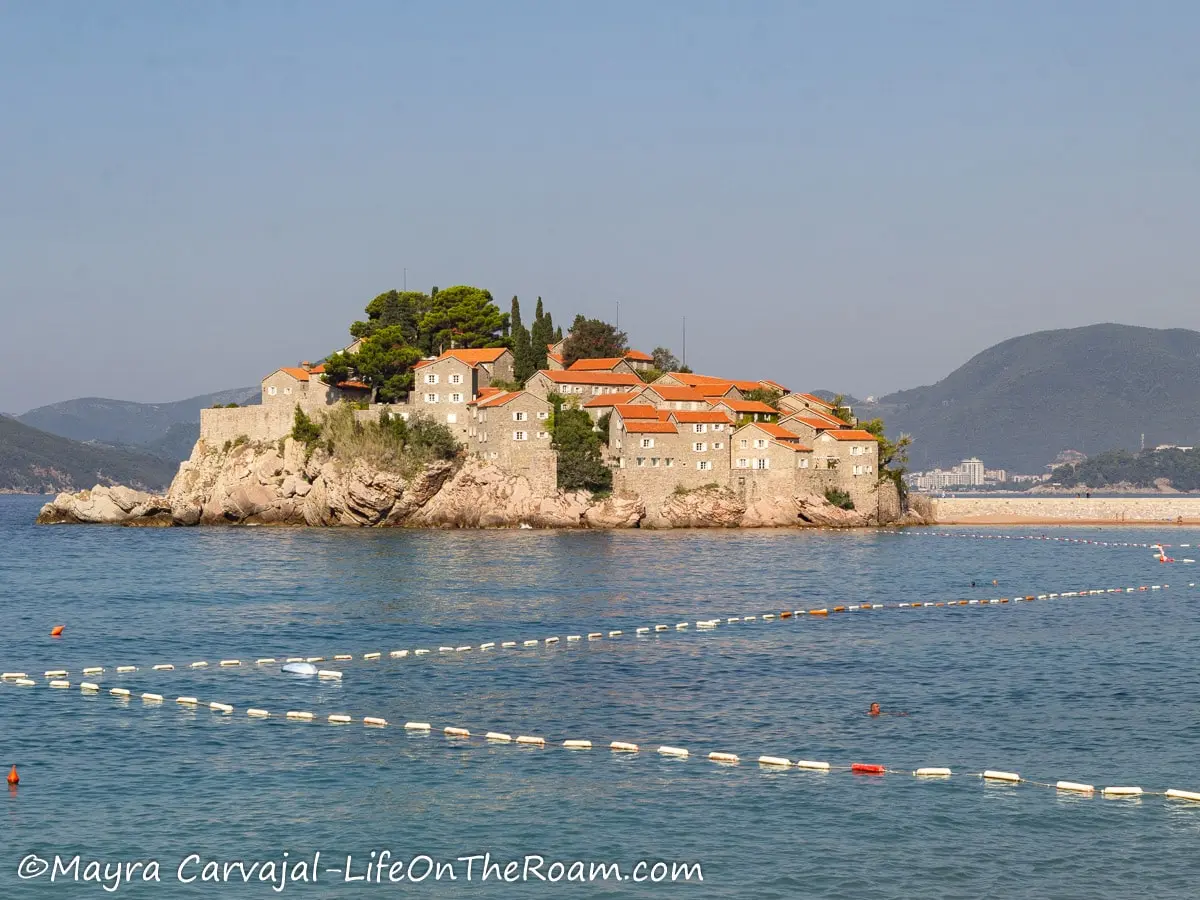
It has a more relaxed vibe than other sites since it’s not surrounded by a gazillion restaurants, even though you still have a few -more expensive- options to eat on site (or you can bring your own snacks).
There are beach loungers with large umbrellas available for rent, with prices that get higher the closer you’re to the water’s edge and the islet, where the beach is nicer. First row can be up to €50 and it gets cheaper the farther back you go.
There’s also an area where you can lay your towel and umbrella, showers and some rickety changing stalls (no public washrooms).
Keep walking north, past the islet, and you’ll reach the “other” side.
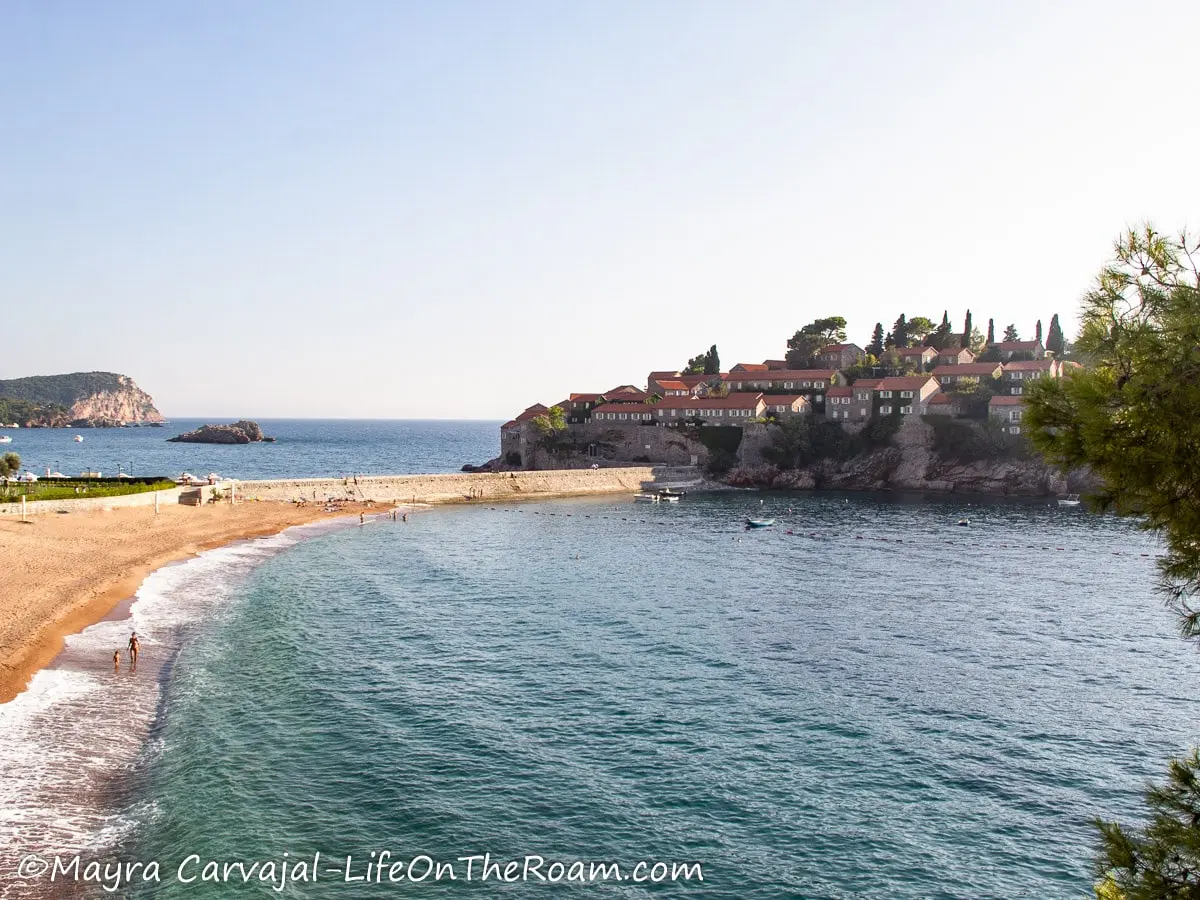
This used to be a beach for the guests of the exclusive Aman Resort, the company that runs (currently under dispute) the facilities inside the Sveti Stefan islet which is now closed, pending negotiations.
So, for now, the north side is also a public beach, with no beach loungers or any service.
Sveti Stefan is my favourite beach in Budva, but there are others on this list that are good contenders for the top spot. My favourite in Montenegro is Queen’s Beach in the outskirts of the city of Bar.
We spent a couple of hours swimming here before walking north along the Seven Bay Trail to explore more coves.
Note: if you drive here be prepared to pay €4/hour for parking.
King’s Beach (Miločer Plaža)
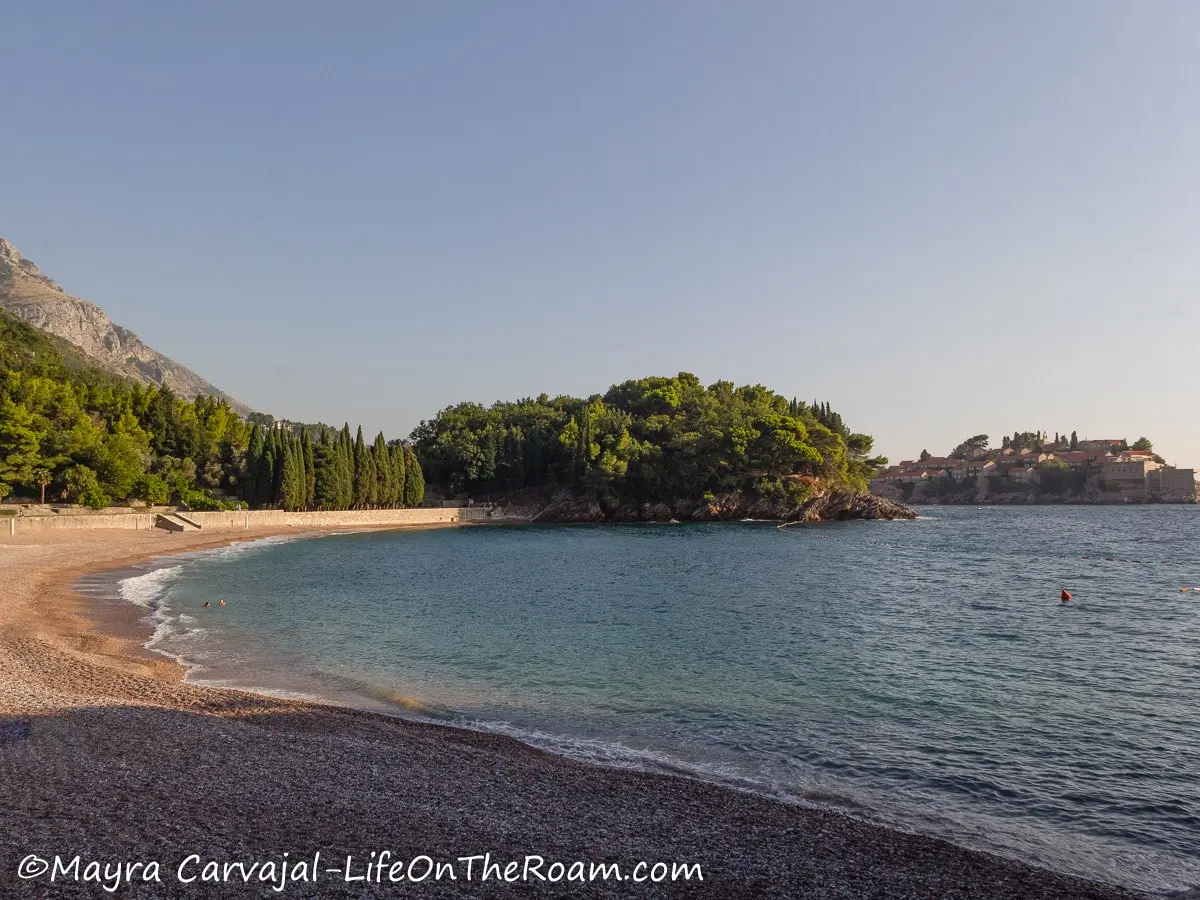
From Sveti Stefan walk north and past Olive Restaurant to find the steps that will take you over a verdant hill and into King’s Beach. Towards the end of the shaded path you’ll enjoy an aerial view of this beautiful cove and the Miločer Park in the background.
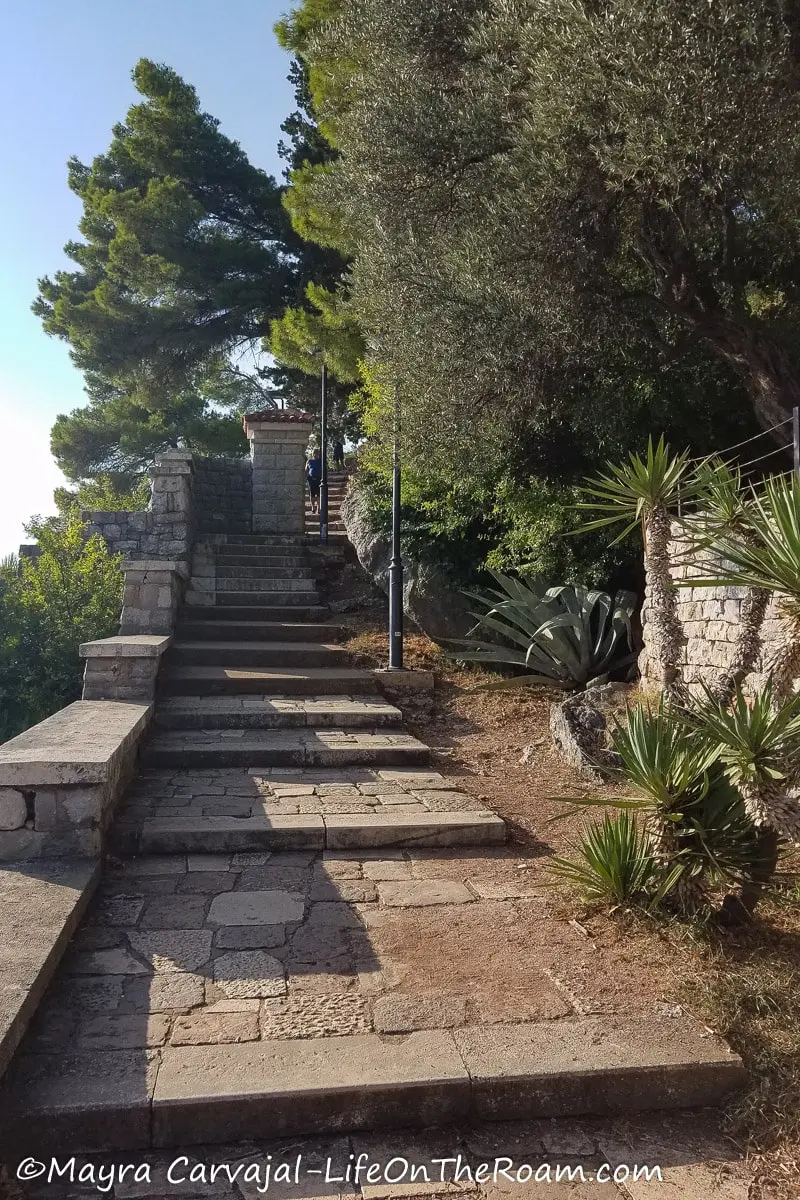
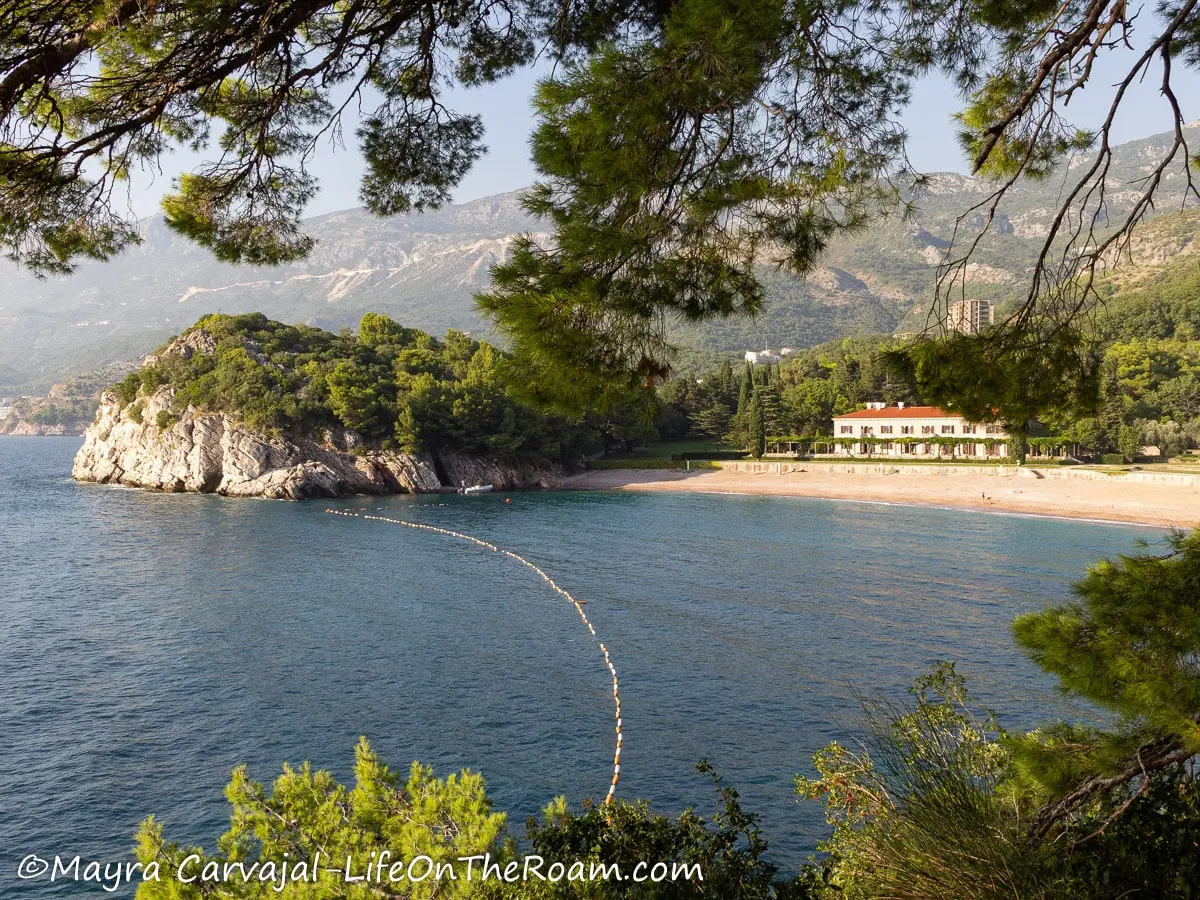
From this tiny multicolour pebble beach with different shades of blue in the water you can catch a view of the Sveti Stefan islet.
For now, access to the beach is free as the Aman resort is still closed (it was mandatory to pay two arms and two legs for beach loungers). There are no facilities whatsoever. If you drive here parking is €2/hour.
Queen’s Beach (Kraljičina Plaža)
Keep walking north to visit this gorgeous beach protected by the cove. It also used to be private as part of the Aman resort, but it’s free at the moment (for now). No facilities whatsoever either.
Pržno Beach
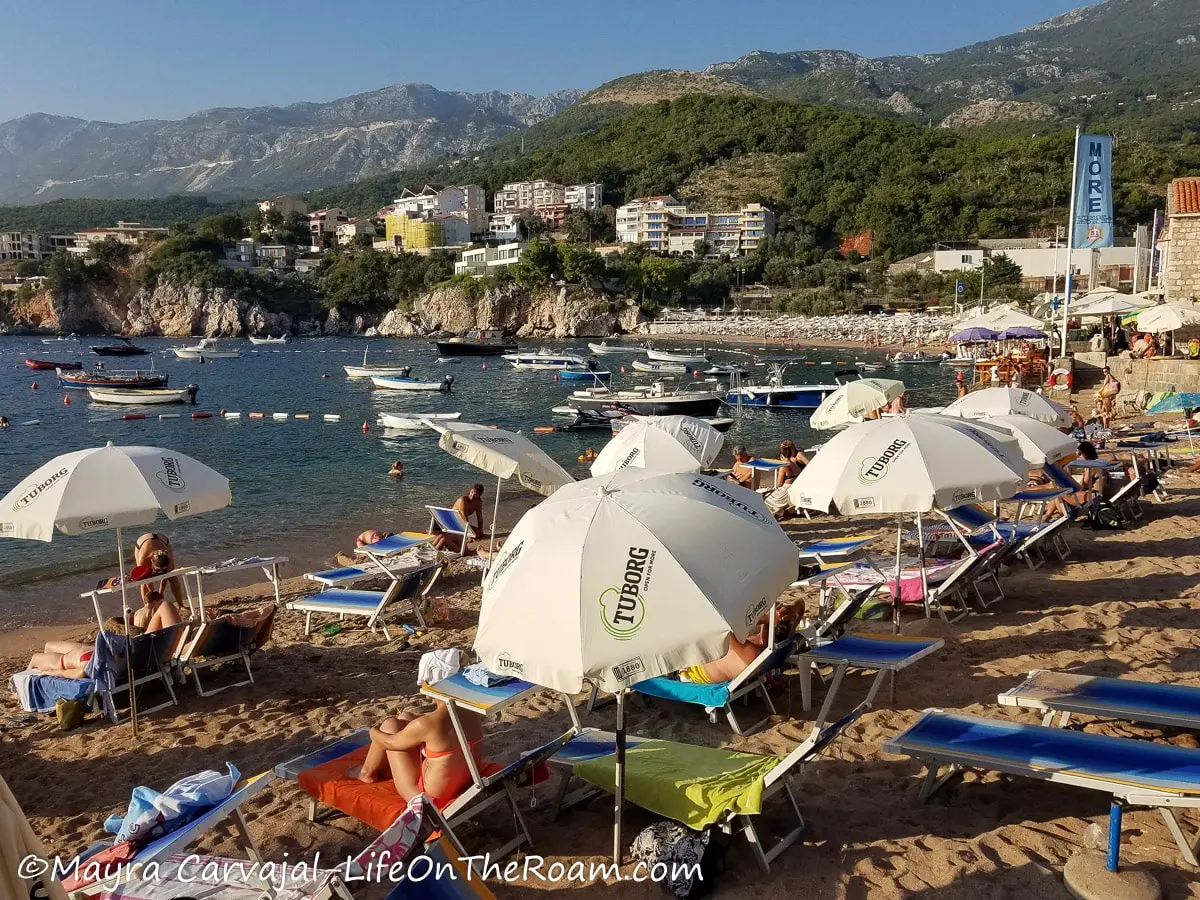
Once you reach Pržno you’ll start hitting the busiest beaches in the Budva Riviera.
Pros:
-It’s a sandy beach
-There are cafés around with scenic views to have a drink right on the water
-It’s a great spot to watch the sunset
Cons:
-It’s small and crowded
-The on-site hotel takes most of the space and charges up to €180 to rent the beach loungers (unless you’re staying at the hotel), leaving a tiny area for people who come with their towels and umbrella.
In my opinion, the scenery is nice but not €180 nice and as for the beach, there are better. To me, watching the sunset from one of the cafés is the best way to enjoy this spot.
Pržno Beach to Kamenovo Beach: walk towards the north end of the beach to find the stairs that will take you up to the main road (E80).
From here, you’ll walk towards Konoba Kusta (a restaurant on the side of the road). You’ll be on a sidewalk most of the time, but the very last -short- section before reaching the restaurant you’ll walk on the road.
Near the restaurant you’ll find a path in the forest that will take you down to the coast and from there walk north to the south tip of Kamenovo Beach.
Kamenovo Beach
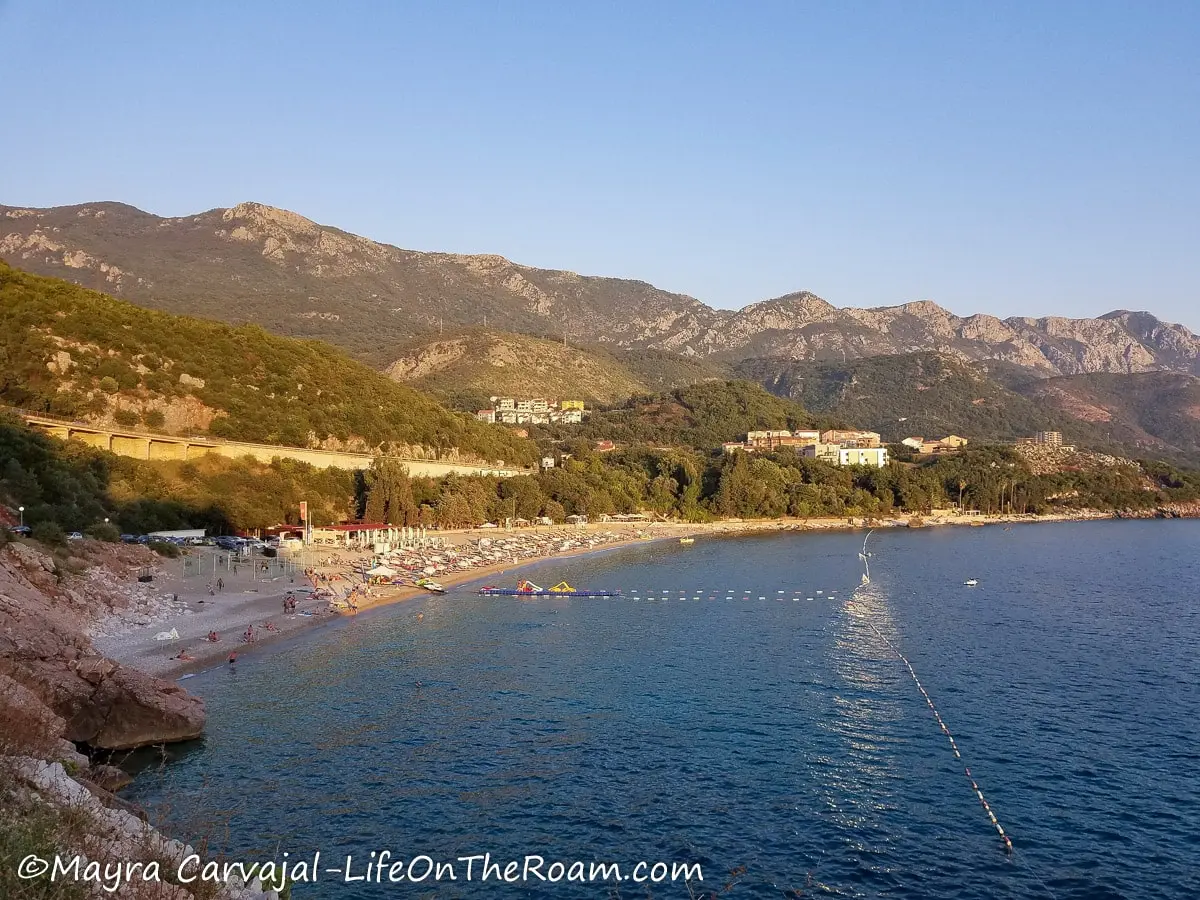
Kamenovo, with a long, wide stretch of pebbly sand, is my second favourite beach in Budva after Sveti Stefan. I had a lovely swim here.
Even with tons of people it doesn’t feel crowded as there’s space for everybody, including an area where you can lay your towel if you don’t want to rent beach loungers, which cost up to €25 depending on what time of the year you visit and what row you choose.
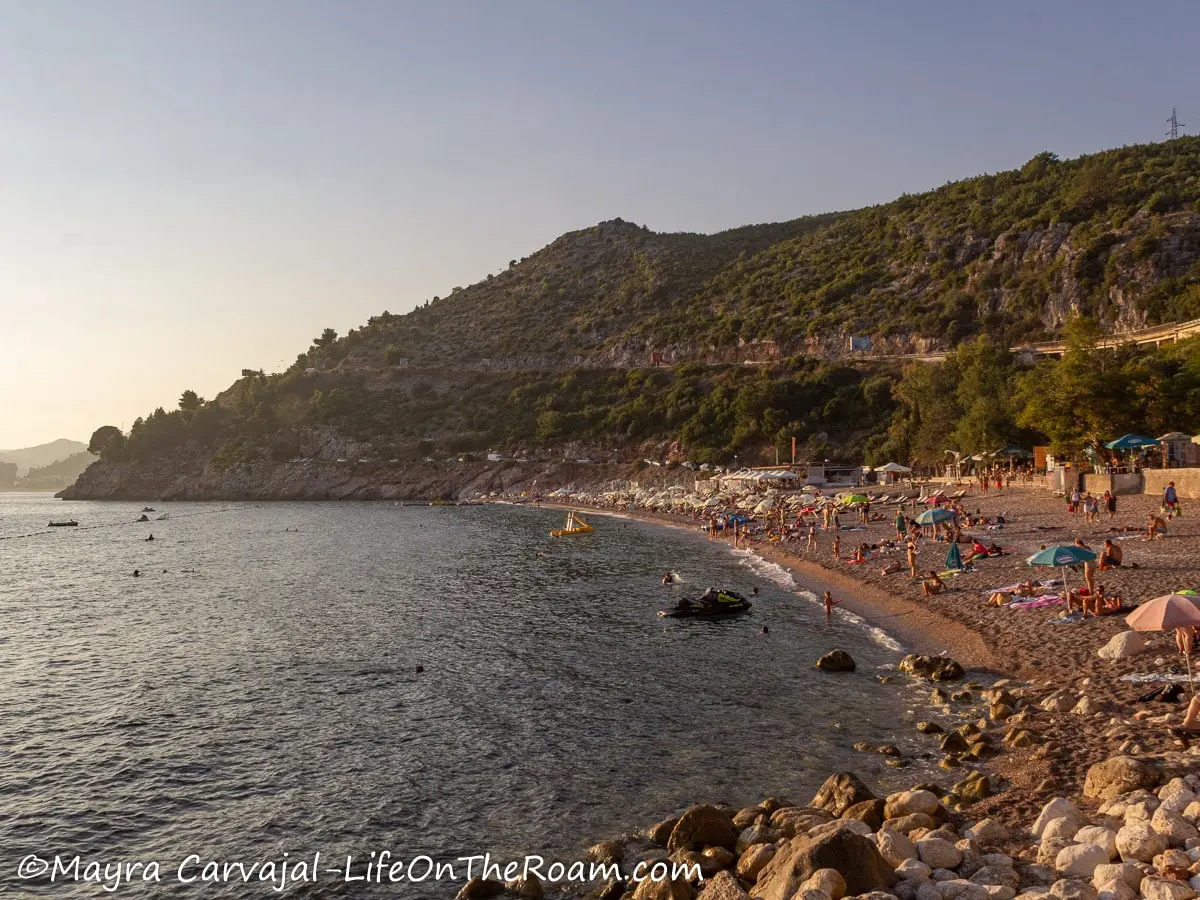
There’s a restaurant on site and showers, as well as jet skis and other water sports equipment for rent.
Parking is conveniently located right on the beach (€5).
Kamenovo Beach to Djevištenje Beach: walk past the parking area and keep going up the access road until you find a pedestrian tunnel carved in the mountain to cross to the other side.
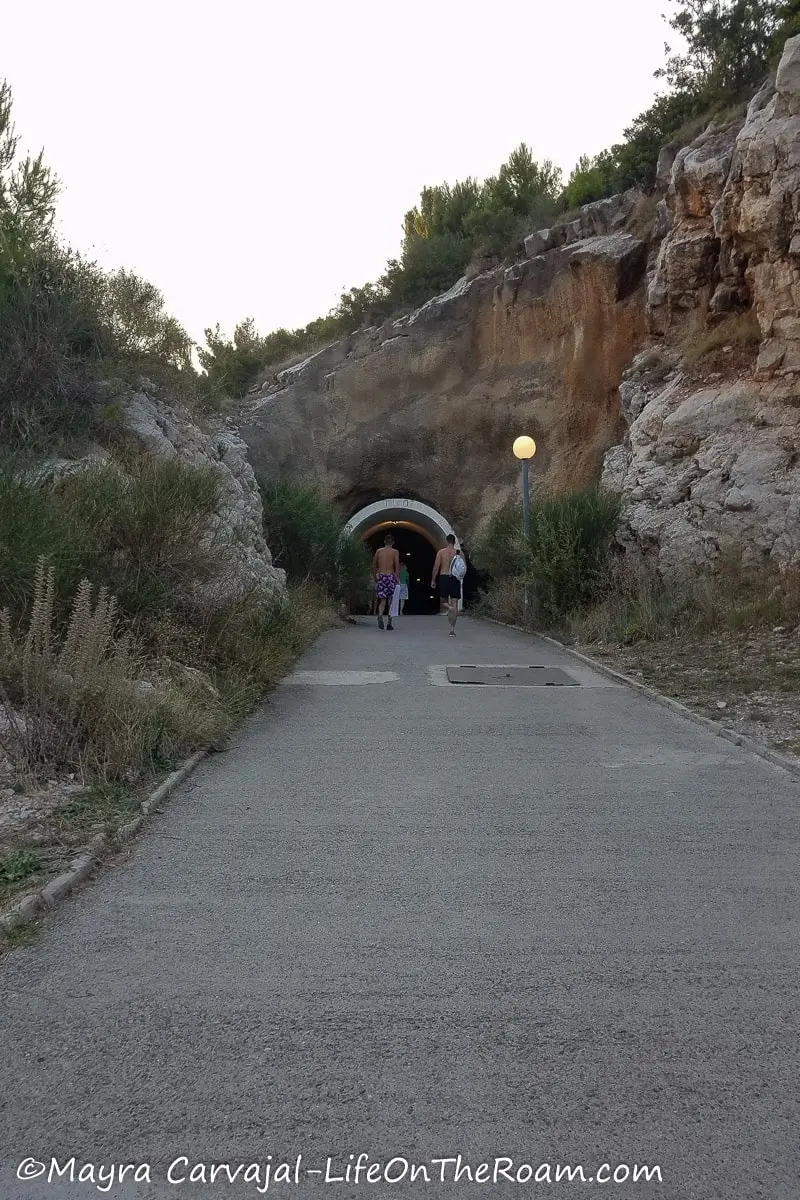
Djevištenje Beach
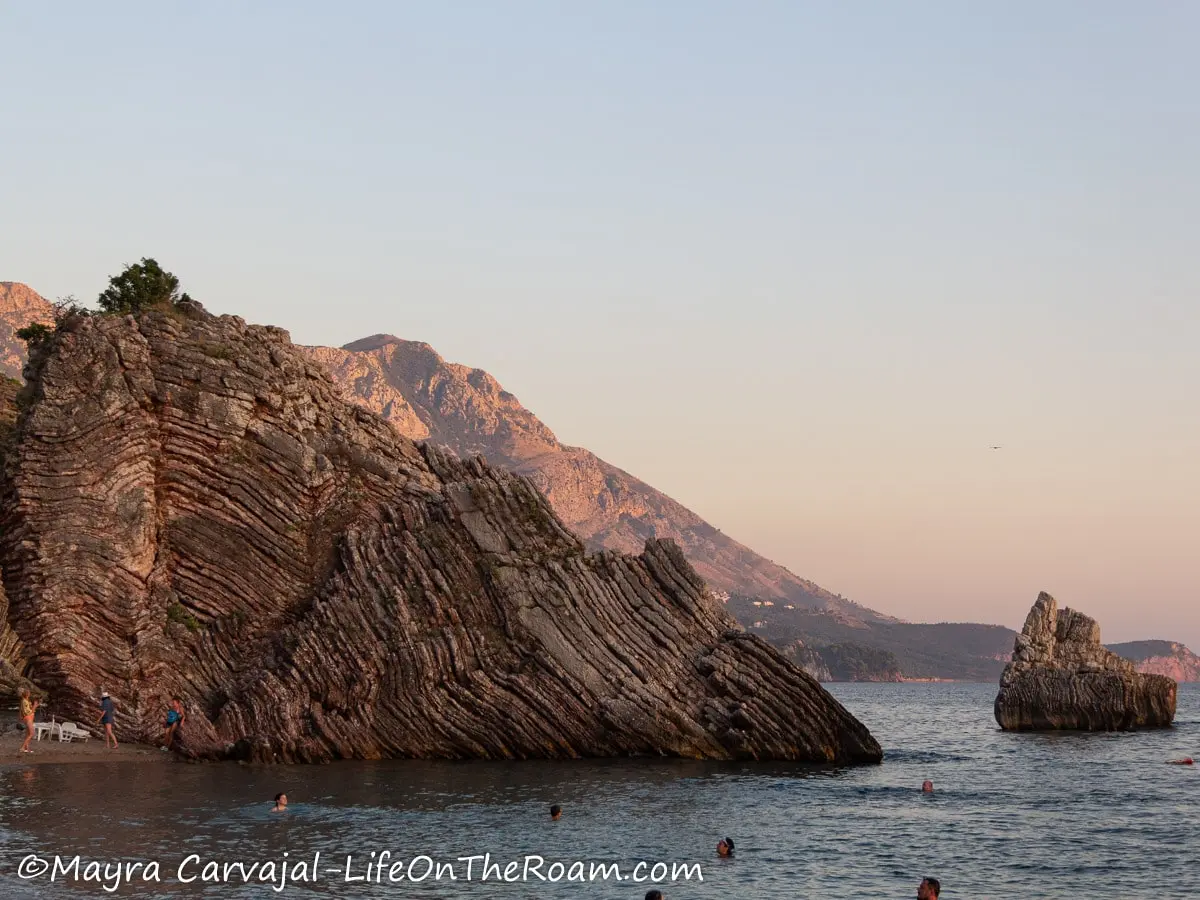
This small, rocky beach offers a wonderful scenery courtesy of two massive rocks that frame the bay, resembling a sinuous layer cake.
There’s a café on site with beach loungers for rent.
Rafailovići Beach

Keep walking northwest on the promenade to find this beach, which is on the narrow side and beyond crowded during the high season. If you come here in the summer, arrive early so you can have a few hours of enjoyment before it goes crazy. There are many restaurants around and beach loungers for rent (as well as lots and lots of cigarette butts in the sand).
Bečići Beach
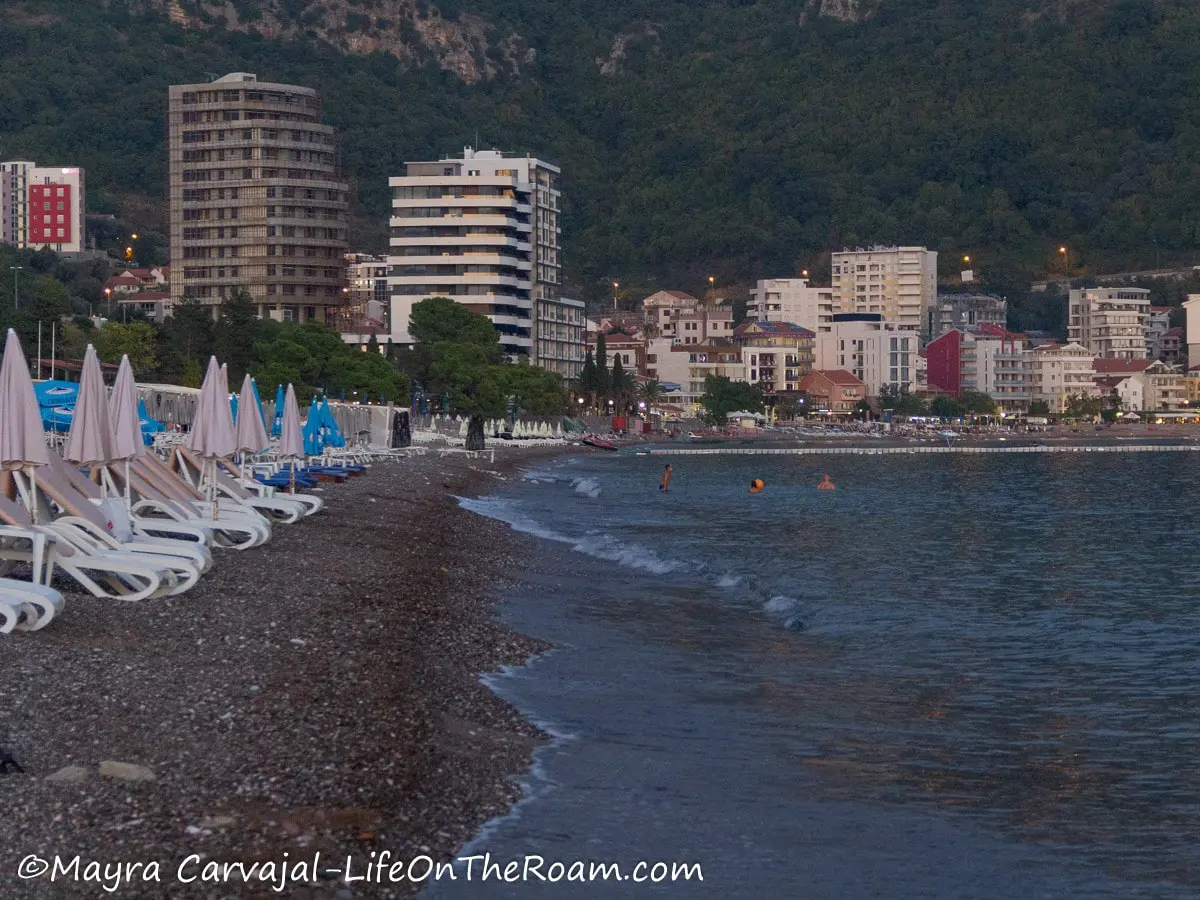
Further west you’ll find this rocky beach which shares pretty much the same good things and not so good things as Rafailovići (if you look at the map it’s just a different section of the same 2-km long beach), with the advantage that it’s wider and longer so it feels less crowded and has more space to lay your towel if you don’t want to pay for beach loungers.
To me, this is a beach to have a long walk, sit at one of its many restaurants and have a drink with a seaview rather than getting in the water (at least during the high season).
Bečići Beach to Slovenska Beach: keep heading west, go past the section labeled Lumbrela Beach and make a right turn on the first walkway you’ll see, which will lead to the Mediteran Hotel, where you’ll turn left.
You’ll reach the Budva tunnel (a pedestrian tunnel with murals), which will take you to Dukley Beach (where you have to pay a deposit to get in as it’s managed by a 5-star hotel), and from there you’ll connect directly to the Budva promenade.
Slovenska Beach

This is the “city beach”, located right in downtown Budva. There’s a promenade that follows along its 1.6-Km length (one mile), with city parks and endless eateries.
There are many beach bars that run different sections of the beach with loungers for rent, and some clear areas where you can lay a towel. The west tip ends in a marina with many boats offering different trips, including popular ones like rides to Hawaii Beach on Sveti Nikola Island and fishing trips.
During the summer it’s beyond crowded and unfortunately it gets dirty.
Note: Budva nightlife concentrates around this area, with many bars and nightclubs to party the night away.
This is the last stop (or first, if you do it backwards) along the 7 Bay Trail. Do the entire walk, some of it or pick the most tempting beach.
Sveti Nikola Island (Hawaii)
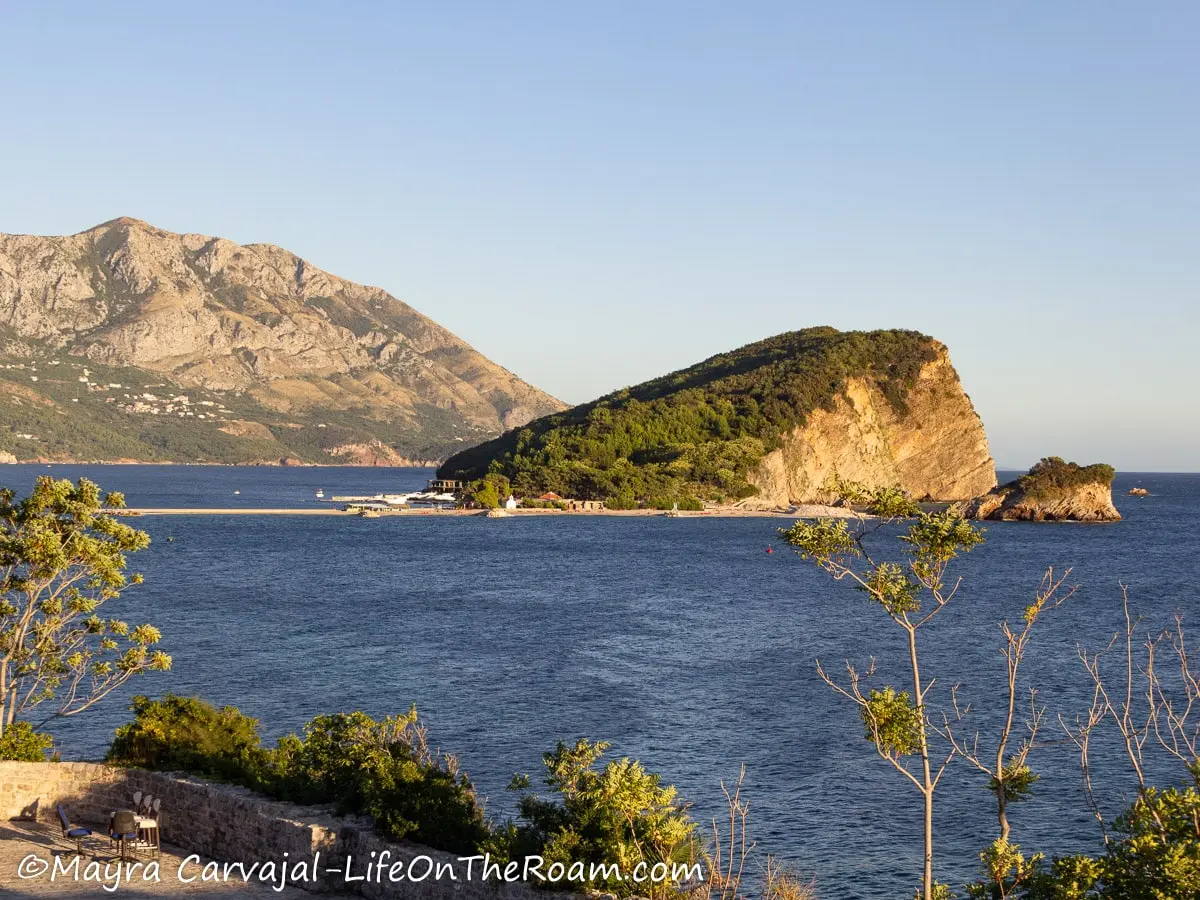
Sveti Nikola Island (Školj) is 800 metres (0.5 miles) across downtown Budva, only a short boat trip or a kayak adventure away. The round trip costs €6p/p, with many boats departing every 30 minutes from the Budva Marina (Slovenska Beach) to Hawaii Beach, on the north tip of the island.
The main attraction here is the beaches on the north side: Hawaii, Sveti Nikola, and Halfmoon Beach. If you have the stamina and experience, you could come here in a kayak and paddle around the island to explore the little caves and nooks and crannies around the coast.
There are showers, beach loungers for rent, and a restaurant on site with less than stellar reviews so we opted to bring snacks with us.
We spent some brief time in Hawaii Beach while we waited for the boat to bring us back to the mainland, and most of the time swimming at Halfmoon Beach, which was my fourth favourite beach in Budva.
Hawaii Beach

Nothing spectacular, but the view of Budva’s coastline and the mountains is nice so it’s great for taking pictures. Clear water, with big rocks instead of sand and the occasional sea urchin so you’re better off wearing wet shoes.
Sveti Nikola Beach

This beach is on the opposite side of Hawaii, with much more space to spread around, a view of the rocky cliffs, and with plenty of rocks.
Halfmoon Beach
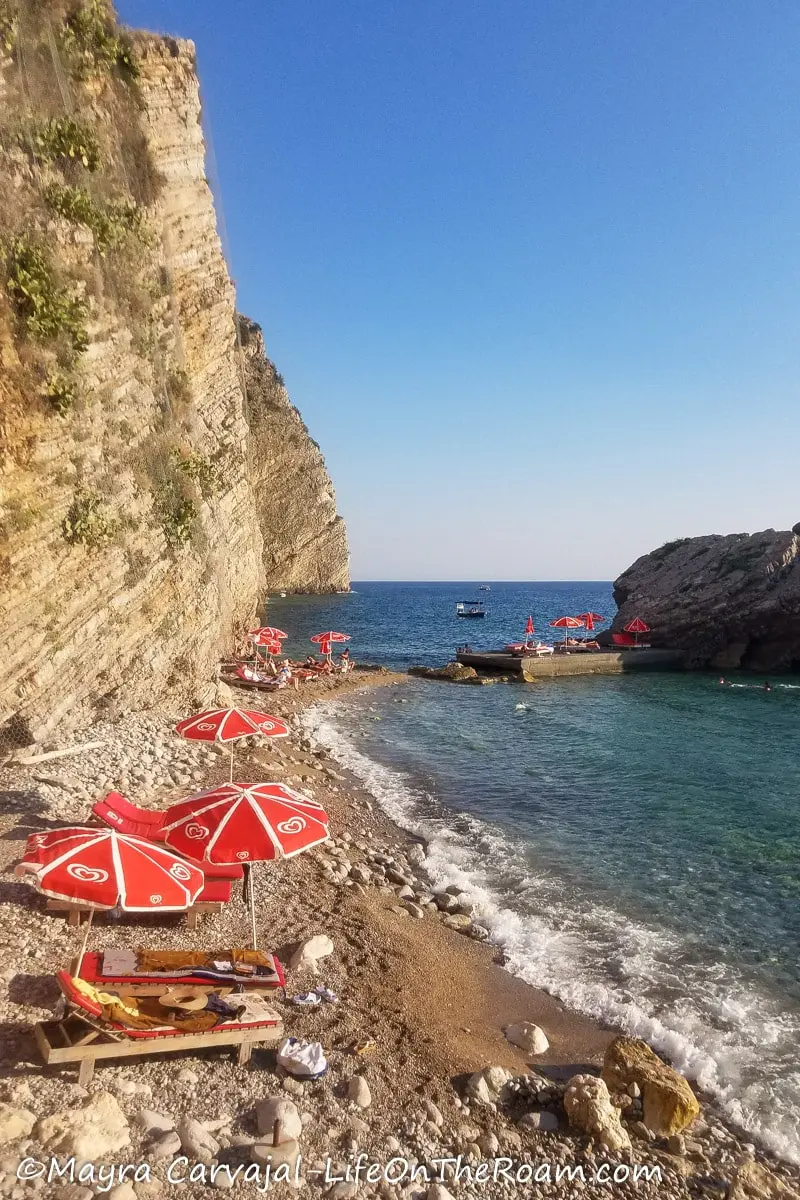
I really, really liked this beach because the scenery is breathtaking. This isn’t a sandy, wide and long beach. It’s exactly the opposite: small, beyond narrow, and with more stones than a quarry, but it’s fantastic for an unforgettable swim in clear deep water amongst huge rock formations, away from the crowds.

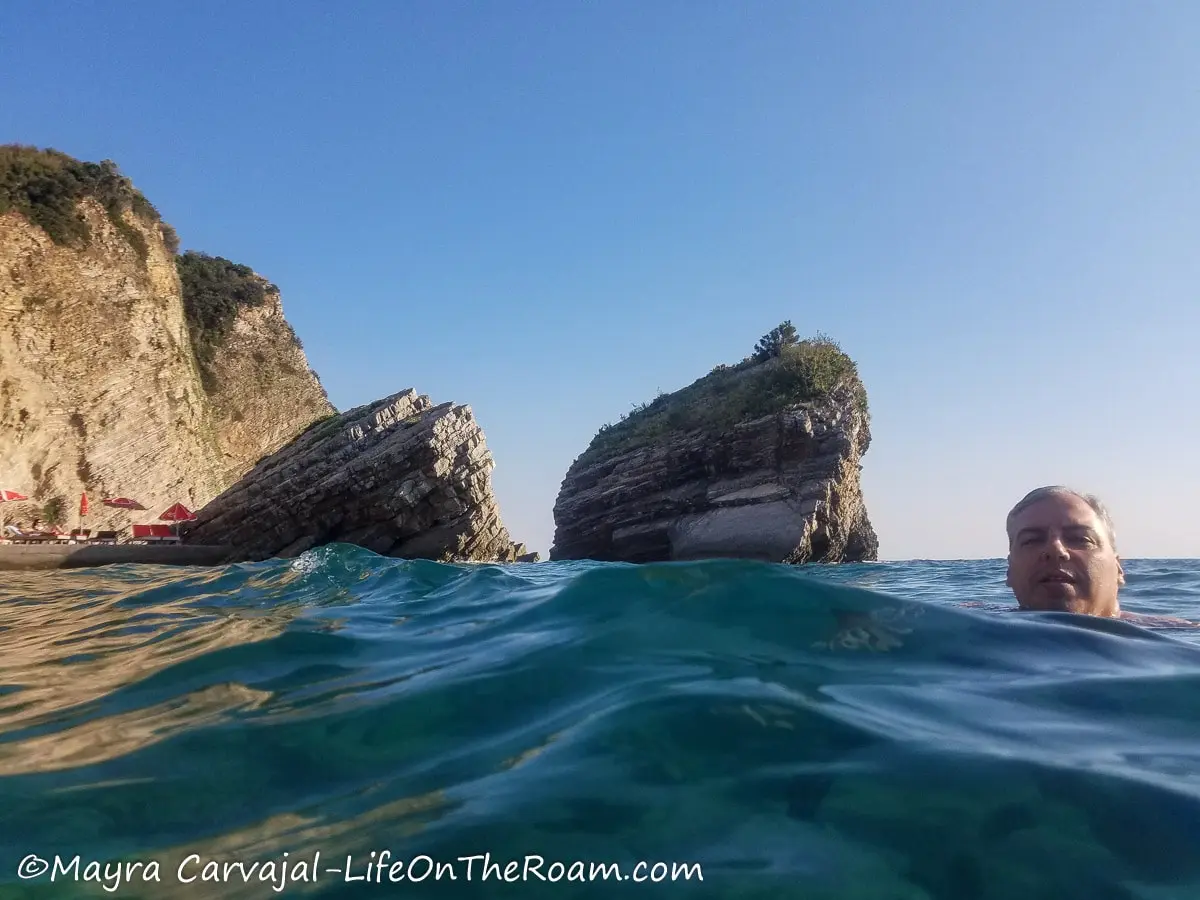
There are rickety beach loungers for rent for €15-20. Bring wet shoes as you’ll need them to step on the rocks when getting in and out of the water. Not the best beach for kids, obviously.
Where to Stay in Budva
Check out these popular hotels in Budva:
Avala Resort & Villas: stay right on the beach, next to Old Town. Select a regular room or a suite with a kitchen, all with breakfast, parking, and high-speed internet included. Facilities include 3 swimming pools, bar, restaurants, and a fitness centre.
Book your stay at Avala, with a rating of 8.9/10 based on more than 2,000 reviews
Dukley Hotel & Resort: a 5-star hotel for a luxurious experience near Bečići Beach. Enjoy a private beach, a rooftop infinity pool, and a free boat transfer to Old Town in the summer. There are restaurants on site and breakfast is included.
Relax at Dukley Resort, with a rating of 9.0/10 based on more than 295 reviews
Four View Apartments: a selection of 1 and 2-bedroom apartments close to Slovenska Beach with a kitchen, AC, flat-screen TV, and a balcony. Sea or city view available.
Stay at Four View, with a rating of 9.4/10 based on more than 415 reviews.
How to Get to Budva
By Air
The nearest airport to Budva is Tivat (TIV). It’s a tiny airport and normally flying there is more expensive. For more options (with possibly lower prices) you can fly to the Podgorica airport (TGD), which is only one hour and change away from Budva.
Check if your accommodation offers airport transfers as public transit from the airport isn’t the best.
By Bus
The Budva bus station is located close to the centre, with frequent buses connecting Budva with main destinations in Montenegro. Trip duration varies according to travel times:
Kotor: around 45 minutes
Cetinje: around 45 minutes
Bar: around 1.25 hours
Tivat: around 35 minutes
Herceg Novi: around 1.75 hours
Ulcinj: around 1.75 hours
Podgorica: around 1.5 hours
For schedule and prices you can check www.busticket4.me
You can buy the ticket online but drivers request a printed copy (Hello,21st century?). The bus station charges a fee to print it. Extra charge for luggage.
Day Trips from Budva
These destinations aren’t far from Budva and make a great day trip, especially when you don’t want to spend much time on the road.
Lake Skadar: big scenic lake with ancient monasteries and one of the best places in Montenegro for birdwatching. Read more about Skadar, the Balkan’s largest lake.
Lovćen National Park: step on its hiking trails and visit its famous mausoleum to enjoy wonderful views of the mountains and the coastline. Learn more about Lovćen here.
Cetinje: the old Royal capital of Montenegro has many museums and a good sample of 19th-century architecture. Read more about Montenegro’s cultural enclave.
Lipa Cave: take a guided trip to see many curious formations inside this cave.
Searching for best rental rates? Check out Rental Cars for savings
How Many Days in Budva
If you only want to visit the Old Town, you can do that in one day, a day trip from Kotor or other nearby urban centres will be enough. But if you also want to enjoy the beaches and the scenic coastal paths then I would plan for a 3-day trip.
If you stay in Budva as your home base to explore the surroundings you can extend your stay to 5 or 7 days according to the number of day trips you want to do.
Packed with many beaches to suit any preferences, this is a lively place with remnants of a glorious past. If you like Budva’s Old Town, plan a day trip to the old fortress in Stari Bar for another dose of history.
YOU MAY ALSO WANT TO READ
BOOKING FLIGHTS AND ACCOMMODATIONS
Book your flight without losing your shirt
We check Momondo to find great deals to book our flights. Also, check Great Escape: it combines the listings from Expedia, Kiwi, Kayak, (and Skyscanner on the premium service) to find the best airfares.
To find a place to stay for less
Booking.com: you’ll find any type of property you can think of in their massive listing, with one of the most comprehensive filters. We’ve found great deals on boutique hotels, apartments, and private rooms in hostels.
Hotwire: the first site I check when we plan to stay at a hotel for a few nights. You can save anything from 20% to 60%. Use the search filter to find what you want and you’ll end up with three listings that match your criteria. You’ll know which one you’ll get after you book. If you can handle a little bit of uncertainty you can score big savings.
House Sitting: you take care of people’s pets and house for free while staying for free. It’s the closest thing to experiencing a place “like a local”. But it comes with responsibilities… Are you an animal lover? It may become your new way to travel.
To get travel insurance
SafetyWing: travel medical insurance that gives us peace of mind knowing that we’re covered in case of emergency. It’s convenient, affordable, and suitable for digital nomads who spend a long time outside their home country.
Check the full list of travel resources on my Resource Page for more options and savings

